
- Customer Reviews
- Net 30 Account
- Wise Services
- Steps & Timeline
- Work at a Glance
- Market Research at a Glance
- Business Plan Writing Services
- Bank Business Plan
- Investor Business Plan
- Franchise Business Plan
- Cannabis Business Plan
- Strategic Business Plan
- Corporate Business Plan
- Merge and Acquisition Business Plan (M&A)
- Private Placement Memorandums (PPM)
- Sample Business Plans
- Professional Feasibility Study
- PowerPoint Presentations
- Pitch Deck Presentation Services
- Business Plan Printing
- Market Research
- L-1 Business Plan
- E-2 Business Plan
- EB-5 Business Plan
- EB-5 Regional Centers
- Immigration Attorneys
- Nonprofit Business Plan
- Exit Business Planning
- Business Planning
- Business Formation
- Business License
- Business Website
- Business Branding
- Business Bank Account
- Digital Marketing
- Business Funding Resources
- Small Business Loans
- Venture Capital
- Net 30 Apply


14 Professional Business Plan Samples [Downloadable pdf]
Looking for business plan examples for inspiration? Download or view 14 business plans examples/samples, vetted by our MBA business plan writers. Download in PDF format or read like a book. These real business plan samples would help in writing your own business plan.

View Real Business Plan Examples/Samples

As an entrepreneur, effectively pitching your idea to attract investors and secure funding can be a challenge. Moreover, when launching a business, creating a comprehensive business plan is paramount.
To aid you in these crucial tasks, we offer a collection of real-world and sample business plan examples across diverse industries. A well-structured business plan is indispensable in the fast-paced entrepreneurial landscape, as it delineates your goals, strategies, and financial projections, providing a clear roadmap for your venture.
Our aim is to facilitate the creation of an effective business plan by integrating real-life examples to elucidate the key elements involved. Below, you’ll find a range of 14 detailed business plan examples available for download and use.
Important Sections to Include in Business Plan
To create a robust business plan, ensure inclusion of the following key sections:
- Executive Summary: A brief snapshot of your business and the key highlights of your business plan. Read more
- Product and Services: An elaborate description of the offerings you will provide to your customers. Read more
- Marketing and Sales Plan: A strategic roadmap outlining how you intend to promote and market your business before, during, and after its launch. Read more
- Operating Planning: An explanation of the systems, processes, and tools necessary to efficiently run your business behind the scenes. Read more
- Organization and Management: Organization and management in a business plan outline the structure and leadership of the company. Read more
- Financial Plan: A comprehensive plan mapping out your short-term and long-term financial goals and the associated costs of running your business. If you require funding, this section is where you can outline your request and financial needs. Read more
- Key External Drivers: External drivers encompass factors like outsourcing, economic changes, industry competition, and business legislation complexity. Read more
- Startup Summary: The startup summary offers a comprehensive financial overview of , detailing expenses, asset value, and total requirements, crucial for transparency with entrepreneurs and investors. Read more
- Projected Industry Growth : Projected industry growth forecasts the sector’s expansion, offering a 10-year perspective and average annual growth rate, providing clarity to investors. Read more
- Break-even analysis: The break-even analysis visually presents key metrics and a 12-month revenue forecast to help stakeholders grasp the point where the business covers costs and starts generating profit . Read more
- Management Summary: The management summary provides a concise overview of organizational structure, key personnel, their roles, and financial commitments, ensuring stakeholders understand the business’s operational strength and leadership capability. Read more
- Financial Indicators: The financial indicators section evaluates organizational fiscal health, focusing on year-over-year profitability metrics, leverage ratios, liquidity ratios, and additional metrics, providing a comprehensive understanding of the business’s financial performance and efficiency in revenue generation from equity investments. Read more
Practical Business Plan Examples Illustrating Strategies for Startup Success

1. E-commerce Plan Sample or Example
Something Borrowed Something New is a burgeoning e-commerce enterprise specializing in wedding accessories and personalized gifts. Operating on a drop-shipping model, this business has the capability to make a significant impact in the market.
Moreover, leveraging social networking and blogging can be instrumental in generating awareness and capturing interest, thereby creating a robust online marketing strategy for Something Old and Something New.
To enhance their business operations, they are contemplating the integration of a WhatsApp CRM system. This initiative aims to optimize communication with potential customers, ensuring prompt responses to inquiries and fostering a seamless interaction process.

2. Online Marketplace Business Plan Example or Sample
EPlace Solutions will be an innovative online marketplace business portal offering a variety of products to consumers throughout the globe. Founded by Mr. John Jones, a seasoned business visionary with an eye toward profit and achievement, the organization is set to enter the market in 2023.
Online shopping is at an all-time high with new consumer mindsets calling for them to shop for the types of deals and bargains that will be so much a part of the online marketplace business model.

3. Snack Bar Business Plan Sample / Business Plan Example
There is an increasing demand for snack-type fast food to be consumed while window shopping and walking around inside a shopping mall.
Do you plan to start a snack bar business? Then here’s a complete snack bar startup business plan template and feasibility report you can use FREE of charge. It sounds easy to open a snack bar, but in reality, you need well-planned strategies to ensure that your business stands the test of time.
Our snack bar business plan sample includes a detailed description of the products and services offered, as well as a market a nalysis and competitive analysis.
It also includes a financial plan that outlines the startup costs, revenue projections, and break-even analysis. We like this sample plan because it demonstrates how to build a profitable snack bar business by creating a unique menu and offering healthy, high-quality snac ks that meet custome r demand.
Your snack shop business plan can look as polished and professional as the sample plan. It’s fun and easy, with Wise Business Plan. Let’s review the snack shop business plan sample and adjust them according to your audience for the best results.

4. Coffee Shop Business Plan Sample/Business Plan Example PDF
A coffee shop business plan is a document that outlines what your business idea is and how it will be implemented. Its purpose is to answer questions such as what it costs to start a coffee shop, how these costs will be financed, and how much money you can expect to earn from your cafe.
Are you looking for the right business plan for your cafe? Let’s review the Coffee shop business plan sample to find out how cloud-based software can make your day-to-day work more efficient.
Our coffee shop business plan sample includes a detailed description of the products and services offered, as well as a market analysis and competitive analysis.
It also includes a financial plan that outlines the startup costs, revenue projections, and break-even analysis. We like this sample plan because it demonstrates how to build a profitable coffee shop business by creating a unique brand and offering high-quality products a nd customer service.

5. Food Hall Business Plan Sample/Business Plan Example PDF
In the food industry, there is fierce competition. To ensure success, you need to hit the ground running with the right pitch. Our food house business plan is the ideal solution with an attractive design highlighting key information and conveying the right message.
This food business plan example features food images intended to tantalize the taste buds. It captures the theme perfectly and will convey the ultimate message to investors, clients and customers.
It is important to remember that the business plan template can be customized to meet your company’s specific needs and requirements. It will help showcase your business as a leader in the modern industry.
This food business plan template provides key slides to showcase everything from finances to marketing and key competitors. If you prefer, you can alter the content displayed to meet your specific needs, but this is a good starting point.
Ultimately, this food house business plan will be suitable for any business operating in the food industry and keen to get interested from key individuals. It will ensure that you can build up the rep of your company.
We provide a one-of-a-kind sales pitch deck designed to appeal to your prospective audience, as well as a custom presentation tailored to their information requirements.

6. Printing Shop Business Plan Sample/Business Plan Example Plan
When establishing a think tank, you will need to develop a business plan and document it properly. As a mass think tank, you need a special strategy to legalize the think tank as a non-profit organization and to raise funds for your project successfully.
Copy and print businesses offer a variety of services to both businesses and consumers. A copy and print shop can handle everything from single-page printing to large-volume jobs using several types of media.
Our printing shop business plan sample includes a detailed description of the products and services offered, as well as a market analysis and competitive analysis. It also includes a financial plan that outlines the startup costs, revenue projections, and break-even analysis. We like this sample plan because it demonstrates how to build a profitable printing shop business by offering high-quality, customized printing services with a focus on customer s ervice and efficient operations.
Let’s take a look at Printing and Photocopy Business Plan Sample that you can use to inspire your own and easily create one.

7. Acquisition Business Plan Sample/ Example PDF
The acquisition business plan sample is intended for businesses seeking to acquire another company or merge with a competitor. This plan includes an analysis of the target company, a valuation, and a strategy for integrating the acquired business into the existing operations. We like this sample plan because it provides a clear roadmap for the acquisition process and demonstrates the potential benefits of the deal.

8. L-1 Visa Business Plan Example with Sample PDF
At Wisebusinessplans, we understand that obtaining an L1 visa for an executive or manager requires a thorough and compelling business plan.
Our L1 business plan sample includes all the necessary components to satisfy USCIS requirements and demonstrate your qualifications and your company’s viability in the US market.
The L1 business plan sample is a comprehensive plan for a new business seeking L1 visa approval for an executive or manager. This plan focuses on demonstrating the applicant’s qualifications and the company’s viability in the US market.
We like this sample plan because it is specific to the L1 visa process and includes all the necessary components to satisfy USCIS requirements.

9. E-2 Visa Business Plan Sample/ Example PDF
If you’re an entrepreneur seeking E-2 visa approval, Wise Business Plans can help you create a persuasive business plan.
Our E-2 business plan sample outlines your investment, business operations, and financial projections, providing a clear and compelling case for your ability to successfully run a business and make a significant economic impact.
The E-2 business plan sample is designed for entrepreneurs seeking E-2 visa approval, which allows individuals to invest in and manage a business in the United States. This plan outlines the applicant’s investment, business operations, and financial projections. We like this sample plan because it provides a clear and compelling case for the applicant’s ability to successfully run a business and make a significant economic impact.

10. EB-5 Business Plan Sample/ Example PDF
If you’re looking to obtain an EB-5 visa by investing in a new commercial enterprise in the United States, Wise Business Plans can help you create a compelling business plan.
Our EB-5 business plan sample includes a description of your business, a market analysis, and financial projections, providing a detailed and persuasive case for the potential success of your venture.
The EB-5 business plan sample is designed for individuals seeking to obtain an EB-5 visa by investing in a new commercial enterprise in the United States. This plan includes a description of the business, a market analysis, and financial projections. We like this sample plan because it provides a detailed and persuasive case for the potential success of the business, which is crucial for obtaining EB-5 visa approval.

11. Investor Business Plan Sample/ Example PDF
If you’re seeking investment from angel investors, venture capitalists, or other private equity firms, Wise Business Plans can help you create a compelling pitch.
Our investor business plan sample includes a pitch deck, financial projections, and a detailed analysis of the market the potential return on investment and the scalability of your business.
The investor business plan sample is intended for businesses seeking to attract investment from angel investors, venture capitalists, or other private equity firms. This plan includes a pitch deck, financial projections, and a detailed analysis of the market opportunity. We like this sample plan because it emphasizes the potential return on investment and the scalability of the business.

12. Nonprofit Business Plan Sample/ Example PDF
At Wisebusinessplans, we’re committed to helping non-profit organizations achieve their social impact goals.
Our non-profit business plan sample includes a mission statement, programs and services, marketing and outreach strategies, and a financial analysis, providing a clear roadmap for establishing or expanding your organization.
The non-profit business plan sample is designed for organizations seeking to establish or expand a non-profit entity. This plan includes a mission statement, programs and services, marketing and outreach strategies, and a financial analysis. We like this sample plan because it demonstrates a strong commitment to social impact and outlines a clear strategy for achieving the organization’s goals.

13. Bank Business Plan Sample/ Example PDF
Whether you’re seeking financing from a bank or other financial institution, Wise Business Plans can help you create a detailed and persuasive business plan.
Our bank business plan sample includes a thorough financial analysis, market research, and a strategy for achieving profitability, highlighting the key factors that banks consider when evaluating loan applications.
The bank business plan sample is tailored for businesses seeking financing from a bank or other financial institution. This plan includes a detailed financial analysis, market research, and a strategy for achieving profitability. We like this sample plan because it highlights the key factors that banks consider when evaluating loan applications, and provides a strong case for the borrower’s ability to repay the loan.

14. Cannabis Business Plan Sample/ Example PDF
The cannabis industry is rapidly growing, and Wise Business Plans can help you enter it with confidence.
Our cannabis business plan sample includes a market analysis, operational strategy, and regulatory compliance a comprehensive overview of the unique challenges and opportunities in the industry and offering a clear roadmap for success.
The cannabis business plan sample is tailored for entrepreneurs seeking to enter the rapidly growing cannabis industry. This plan includes a market analysis, operational strategy, and regulatory compliance plan. We like this sample plan because it provides a comprehensive overview of the unique challenges and opportunities in the cannabis industry, and offers a clear roadmap for success.
Detailed Overview of Key Components of a Business Plan
1. executive summary.
The executive summary is a concise overview of your business plan, highlighting the key points of each section. It should capture the essence of your business, its mission, and the purpose of the business plan. This section should be written last, but it’s placed at the beginning of the business plan. Here is an example executive summary from our professional business plan written for Eplace Solution , an innovative e-commerce portal.

Tips for Writing Executive Summary
- Keep it brief and focused on key points.
- Clearly define the problem and your solution.
- Highlight market opportunities and growth potential.
- Showcase your team’s qualifications.
- Include financial projections.
- End with a clear call to action.
- Tailor it to your audience.
- Review and update regularly.

2. Company Overview or Description
In this section, provide a detailed description of your company, including its history, legal structure, location, and vision. Explain your mission statement and core values that guide your business decisions. Use real-life examples of successful companies and how their strong company descriptions have contributed to their growth. In addition, you can reuse your company description on your About page, Instagram page, or other properties that ask for a boilerplate description of your business.
This section also allows you to describe how you register your business . Here you must choose whether your business is a corporation, sole proprietorship, LLC , or another type of business .

Tips for Writing Company Description
- Describe your company’s mission and vision.
- Explain what your business does and the problems it solves.
- Mention your target market and customer base.
- Highlight your unique selling points.
- Provide a brief history and background.
3. Market Analysis
A market analysis analyzes how you are positioned in the market, who your target customers are, what your product or service will offer them, and industry trends. It might be useful to do a SWOT analysis to discover your strengths and weaknesses to identify market gaps that you may be able to exploit to build your business.
As part of your market research, you’ll also need to perform a competitive analysis. It will give you an idea of who your competition is and how to differentiate your brand. Here’s an example of a competitive analysis we did for a food business.

Tips for Writing Market Analysis
- Research and understand your industry thoroughly.
- Identify market trends and growth opportunities.
- Analyze your competitors and their strengths and weaknesses.
- Define your target audience and their needs.
- Include data and statistics to support your analysis.

4. Product and Services
Adding products and services to a business plan involves more than listing your company’s offerings. If you intend to gain funding or partner with another business, your products, and services section needs to demonstrate your company’s quality, value, and benefits.
Here’s an example of a product and service section in the business plan we wrote for an e-commerce business that offers wedding accessories.

Tips for Writing Product and Services
- Clearly describe your offerings and their features.
- Explain how your products/services address customer needs.
- Highlight any unique qualities or advantages.
- Discuss your pricing strategy.
- Mention any future product/service development plans.
Here is example of services section of a bank.

5. Marketing and Sales Plan
It is always a good idea to have a marketing plan before launching your business. A potential investor will want to know how you will advertise your business. Therefore, you should create a marketing plan that explains your planned promotion and customer acquisition strategies.
Discuss how you will make a sale. How will you attract customers and maximize their lifetime value? Ensure your marketing and sales forecasts align with your financial forecasts Marketing plans are usually based on the four Ps : product, price, place, and promotion. Breaking it down by marketing channels makes it easier. Discuss how you intend to market your business via blogs, email, social media, and word-of-mouth. Here is an example of marketing strategies we develop for a restaurant business.

Tips for Writing Marketing and Sales Plan
- Define your marketing goals and objectives.
- Outline your marketing strategies, including channels and tactics.
- Explain your sales strategy and target sales goals.
- Include a budget for marketing and sales activities.
- Discuss your sales team and their roles.
- Detail your customer acquisition and retention strategies.
- Mention any partnerships or collaborations for marketing and sales.
Example of marketing and sales plan section of a bank

6. Operation Planning
The operation plan should include all the steps needed to run the business in the long run. The plan should include details about logistics, duties for each department of the company, and responsibilities for the team.
The main aspect of running a business is its costs. Whether it’s machinery or services, each requires capital.
how to write an operation plan in a business plan
Tips for Writing Operational Planning
- Describe your day-to-day business operations.
- Explain your supply chain and production processes.
- Outline your facility and equipment requirements.
- Discuss your quality control and efficiency measures.
- Mention any legal and regulatory compliance considerations.
- Detail your staffing and management structure.
- Include contingency plans for potential disruptions.
7. Organization and Management
In this section, you can describe your current team and the people you need to hire. You will need to highlight your team’s relevant experience if you intend to seek funding. Basically, this is where you demonstrate that this team can be successful in starting and growing the business.

Tips for Writing Organization and Management Summary
- Introduce your leadership team and their roles.
- Highlight their relevant experience and qualifications.
- Explain your organizational structure and hierarchy.
- Discuss key personnel responsibilities and functions.
- Mention any plans for team growth or development.
- Address any advisory boards or external support.
Management summary of coffee shoppe business.

8. Financial Plan
A financial plan should include sales and revenue forecasts, profit and loss statements , cash flow statements , and balance sheets .
Now, if you plan to pitch investors or submit a loan application, you’ll also need a “use of funds” report. Here you outline how you plan to leverage any funding you might acquire for your business.
With our business templates , you can create your own income statement, cash flow statement, and balance sheet.

Tips for Writing Financial Plan
- Include detailed financial projections (income statement, cash flow, balance sheet).
- Explain your funding requirements and sources.
- Discuss your pricing and revenue model.
- Describe your expense management and cost controls.
- Mention any financial risks and mitigation strategies.
- Highlight key financial milestones and goals.
Financial highlights of foodShack business.

9. Key External Drivers
External drivers refer to the external factors or influences that significantly impact the activity and growth of an industry. These drivers include outsourcing of non-core activities, changes in economic activity, competition from other industries, and the complexity of business legislation.
Additionally, external drivers encompass the effects of changes in new business formation, especially among small businesses, which directly affect the demand for services within the industry.

Tips for writing key external drivers
- Identify and analyze current and emerging market trends in your industry.
- Assess potential positive or negative impacts these trends may have on your business.
- Evaluate broader economic conditions, including inflation rates, interest rates, and GDP growth.
- Elucidate how changes in economic conditions could influence consumer behavior, product demand, and overall cost structure.
- Outline key industry regulations and compliance requirements, discussing potential impacts on operations, costs, and market access.
- Highlight relevant technological advancements and explain their potential effects on your product or service offerings, operations, and competitiveness.
- Analyze current and potential future competitors, emphasizing the evolving competitive landscape’s impact on market share, pricing strategy, and overall business strategy.
- Consider social and cultural factors influencing consumer preferences and behaviors, exploring how societal changes can affect product demand.
- Evaluate environmental trends and regulations, discussing potential impacts on operations, supply chain, and customer perceptions.
- Assess political stability, government policies, and geopolitical factors, exploring potential risks and opportunities from political changes.
- Discuss global market conditions, analyzing how global economic trends, trade policies, and currency fluctuations may affect operations and expansion plans.
- Identify and discuss potential risks in the supply chain, such as disruptions, shortages, or geopolitical issues.
- Consider demographic shifts affecting your target market and discuss how changes may impact your customer base and marketing strategies.
- Highlight key legal and regulatory factors affecting the business, discussing potential legal challenges, compliance costs, and regulatory changes.
- Outline comprehensive risk management strategies, including contingency plans and risk mitigation strategies.
- Explain how you will monitor external drivers and emphasize the importance of staying agile and responsive to changes in the external environment.

10. Startup Summary
The startup summary serves as a comprehensive overview of essential financial aspects, encompassing total startup expenses, the overall value of startup assets, and the total requirements, which is the cumulative sum of all expenses and startup investments.
It provides a clear financial snapshot, outlining the costs involved in launching the business, the value of assets acquired, and the overall financial needs for the startup.
This section is crucial for entrepreneurs and potential investors, offering a transparent understanding of the financial foundation required to initiate and sustain the business successfully.
This roadmap ensures a realistic evaluation of the business idea, identifying potential challenges and offering solutions.To write an effective plan, focus on what sets your venture apart from competitors, maintain conciseness, and embrace flexibility as a living document.
Answer fundamental questions about your business, create actionable checklists, execute the plan, and continually revise and update based on experiences and feedback.This iterative process fosters continuous improvement, helping entrepreneurs stay adaptable and enhance their business strategies over time.

Tips for writing Startup Summary
- Clearly state the startup’s name and provide a concise description of its activities.
- Include a succinct mission statement capturing the startup’s purpose and goals, reflecting its core values.
- Specify the founding date and offer brief bios of key founders, highlighting relevant experience.
- Summarize the startup’s concept, explaining offered products or services and key distinguishing features.
- Clearly articulate the problem or need in the market that the startup addresses, defining the target audience.
- State what makes the startup unique, whether it’s a special feature, market gap, or competitive advantage.
- Provide a brief description of the market opportunity, covering target market size, trends, and growth prospects.
- Outline how the startup plans to generate revenue, detailing streams, pricing strategy, and potential partnerships.
- Offer a snapshot of the startup’s current status, highlighting key achievements such as product development or partnerships.
- If seeking funding, clearly state the amount sought and its allocation, covering areas like product development and marketing.
- Include a high-level financial summary with key projections for revenue, expenses, and profitability.
- Briefly outline future aspirations and plans, encompassing areas like expansion, product development, or strategic partnerships.
11. Projected Industry Growth
The projected industry growth is a pivotal aspect that forecasts the expansion of a specific sector over a defined timeframe.
For instance, it could provide an estimate of where that particular business will be standing in the next 10 years, and what will be the average annual growth rate of that industry.
This information provides prospective investors and stakeholders with a clear understanding of the industry’s potential and positions the startup within a dynamic and flourishing market.

Tips for writing Projected Industry Growth
- Emphasize the importance of industry trends and growth to your business.
- Provide a concise overview, including market size, major players, and recent trends.
- Briefly explain how you gathered data on industry growth projections (e.g., market research reports, expert interviews).
- Identify and discuss prevailing trends, such as technological advancements, changes in consumer behavior, and regulatory shifts.
- Summarize the industry’s historical growth, highlighting growth rates, market expansion, and notable milestones.
- Highlight key factors expected to drive industry growth, such as emerging markets, technological innovations, and demographic shifts.
- Discuss specific opportunities within the industry, including gaps in the market, underserved segments, or areas of competitive advantage.
- Acknowledge potential challenges or risks that could impact industry growth, demonstrating a realistic understanding.
- Present projections for future growth rates based on historical data, expert opinions, and your analysis. Include short-term and long-term projections.
- Discuss how key competitors are positioned to leverage industry growth, emphasizing your business’s differentiation strategies.
- Consider the regulatory landscape impacting growth, discussing anticipated changes and their potential effects on the industry.
- Explore international trends and their implications for industry growth, including factors like global economic conditions and geopolitical influences.
Here is example of market analysis section of a bank.

12. Break-even Analysis
The break-even analysis serves as a vital financial tool, offering a detailed estimation of key metrics such as Sales Revenue, Cost of Sales, Gross Profit, Fixed Expenses, and Income Before Tax.
These critical components are visually presented through a bar graph, providing a clear and concise overview of the financial dynamics.
Additionally, the break-even analysis delves into a 12-month forecast, outlining the projected amount of revenue generated and the corresponding fixed costs.
This section is instrumental in helping stakeholders understand the financial threshold at which the business covers its costs and begins to generate profit.

Tips for writing Break-even Analysis
- Define break-even analysis as a financial calculation where total revenue equals total costs.
- Identify constant costs regardless of production or sales levels.
- Enumerate and explain costs changing with production or sales.
- Present the break-even analysis formula, indicating the units needed to cover costs.
- Perform a practical break-even calculation using business-specific fixed costs, selling price, and variable cost per unit.
- Include a break-even chart or graph for a visual understanding of cost-revenue dynamics.
- Conduct a proactive sensitivity analysis to explore how changes in variables impact the break-even point.
- Specify the anticipated timeframe to reach the break-even point in terms of months or units sold.
- Clearly outline assumptions made in the analysis and provide justifications for transparency and credibility.
- Acknowledge potential risks or challenges that may affect the accuracy of the break-even analysis.
- Briefly mention contingency plans for difficulties in reaching the break-even point within the projected timeframe.
13. Management Summary
The management summary within the business plan provides a concise overview of the organizational structure and key personnel.
This includes a count of individuals, specifying the number of founders and operational team members integral to the organization.
The summary delves into the roles and responsibilities of each key figure, offering insights into the leadership dynamics driving the business.
Furthermore, the management summary sheds light on the financial aspect by presenting details about personal wages and payroll allocations for both founders and operational staff.
This comprehensive section ensures a clear understanding of the human resource framework and the financial commitments associated with the management team, crucial for stakeholders evaluating the business’s operational strength and leadership capability.

Tips for Writing Management Summary
- Highlighting the critical role the management team plays in the business’s success, the introduction emphasizes their significance.
- Listing each key member with names, positions, and brief role summaries introduces the core of the management team.
- Providing brief biographies for each team member underscores their relevant experience, skills, achievements, and industry-specific expertise.
- Clearly outlining roles and responsibilities emphasizes how each team member’s skills contribute to the overall success of the business.
- Sharing the team’s vision and strategy involves discussing key strategic goals and outlining the plans to achieve them.
- Highlighting notable achievements or milestones showcases the team members’ successful ventures, industry recognition, or career accomplishments.
- Discussing team dynamics emphasizes collaboration and the complementary nature of their skills in driving the business forward.
- Introducing advisory board members, if applicable, underscores the additional guidance and expertise they bring to the business.
- Discussing how the team plans to contribute to future growth and development includes strategies for talent acquisition, leadership development, and succession planning.
- Touching on the team’s culture and values emphasizes their role in shaping the overall ethos of the business.
- If seeking investment, briefly mentioning how the management team plans to use funding for business growth and development provides insight into their financial strategy.
Here is example of marketing and sales plan section of a bank.

14. Financial Indicators
The financial indicators section within the business plan helps in evaluating the fiscal health and performance of the organization.
Year-after-year profitability estimates take center stage, encompassing key metrics such as gross margin, net profit margin, and EBITDA to revenue.
These indicators provide a comprehensive understanding of the business’s ability to generate profit relative to its revenue.
Furthermore, the financial indicators extend to leverage ratios, including the critical Debt to Equity ratio, Debt to Assets ratio, and Interest Coverage ratio.
These metrics illuminate the organization’s capital structure, debt management, and its capacity to meet interest obligations.
Liquidity ratios includes the Current Ratio and Current Debt to Total Asset Ratio.
These ratios provide insights into the company’s short-term financial health and its ability to meet immediate obligations.
The financial indicator toolbox is enriched with additional metrics, notably the Revenue to Equity ratio, which sheds light on the efficiency of generating revenue from equity investments.

Tips For Writing Financial Indicators
- Detailed revenue forecasts for the next 3-5 years. Breakdown by product/service and geographical regions.
- Detailed breakdown of anticipated expenses. Include fixed and variable costs, operational expenses, and other relevant expenditures.
- Historical P&L statements if available. Projected future profits and losses based on revenue and expense projections.
- Outline of expected cash inflows and outflows. Emphasis on the ability to meet short-term obligations.
- Snapshot of the company’s financial position. Includes assets, liabilities, and equity.
- Calculation and presentation of key financial ratios (liquidity, solvency, profitability). Discussion on the significance of these ratios.
- Identification and explanation of relevant KPIs. Highlighting alignment with the overall business strategy.
- Discussion of potential financial risks. Mitigation strategies and addressing uncertainties.
- Clear statement of the amount and purpose of funds required.
- Outline of key assumptions underlying financial projections. Rationale for these assumptions.
- Summary of industry financial trends and business positioning. Outlook on future financial prospects considering market dynamics.

Discover Business Plan Formats and Free Templates
Looking For The Right Business Plan Format?
These sample business plans will provide you with a complete structure and format for your business plan, which will give you a head start on developing your document, so you won’t be stuck seeing an empty page and wondering what to write.
Simply going through the process of writing a business plan is one of its key benefits. If you sit down to write, you’ll naturally think about your startup costs, your target market , and any market analysis or research you’ll need to conduct. In addition to defining your position among your competitors, you will establish your goals and milestones.
You can see what should be included in a sample financial plan, but It is wrong to assume that a sample company’s financial projections will fit your own. If you need more resources to get you started, we recommend this guide on how to write a business plan .
In addition, you can download our 40+ free business plan templates covering a range of industries.
Business Plan Examples For Students PDF
Common types of business plan, 1. one page business plan.
One-page business plans are short, compact, and to the point and are designed to make the plan easy to read at a glance. Make sure to include all of the sections, but truncate and summarize them
2. Start-up business plan
Start-up business plans are for businesses that are just getting started. They are usually developed to secure outside funding. In this regard, financials are of increased importance, as well as other sections that determine whether your business idea is viable, such as market research.
3. Strategic business plan
A strategic business plan lays out a company’s goals and how it will achieve them at a high level. It is a foundational document for the company as a whole. A strategic business plan allows all levels of the business to see the big picture, inspiring employees to work together to reach the company’s goals.
4. Feasibility business plan
Developing a feasibility plan answers two primary questions about a business venture: who would purchase the service or product the company wants to sell, and if the venture is profitable.
5. Internal business plan
Internal Business plans are geared to a specific audience within a company to keep your team on the same page and focused on the same goals.
Conclusion
In conclusion, whether you’re venturing into a traditional business or creating an innovative startup, the significance of a well-crafted business plan cannot be overstated. Different types of business plans cater to specific needs, from internal alignment to strategic expansion. Employing a template in MS Word ensures a polished presentation. The process of writing an executive summary, creating a plan, and defining the components of your business plan is essential.
Recognizing the need for a comprehensive and standard business plan can help guide your endeavors. Whether you choose to write a full business plan or opt for a one-page business overview, leveraging templates in MS Word can simplify the process. In essence, understanding the types of business plans and utilizing an executive summary template provides a structured approach to showcase your business overview.
Take inspiration from example business plans to tailor your strategy, ensuring a roadmap for success in the dynamic world of entrepreneurship. Always remember, a meticulously crafted business plan not only communicates your vision effectively but also serves as a valuable resource that can help secure investments and guide your business’s growth trajectory.
Frequently Asked Questions
Begin with an executive summary, delve into market analysis, outline your strategies, create financial projections, and use available business plan examples as templates to guide your writing.
A comprehensive business plan template should encompass key sections such as an executive summary, business description, market analysis, marketing strategy, organizational structure, and financial projections. Seek templates online that cover these elements.
Tailor your business plan to the scale of your small business. Define your objectives clearly, outline cost-effective strategies, and emphasize agility in adapting to market changes.
Explore well-crafted business plan examples you can visit our website wisebusinessplan.
The fundamental components include an executive summary, business description, market analysis, marketing and sales strategy, organizational structure, product/service description, and financial projections.
Investors focus on growth potential, detailed financial projections, market analysis, competition analysis, and the qualifications and experience of your management team when reviewing a business plan.
To find a business plan example for a tech startup,you can visit our visit wisebusinessplan .
A business plan provides a comprehensive overview of your entire business, including strategies, operations, and financials. In contrast, a business proposal typically focuses on a specific project or offer, outlining the details and benefits to a potential client.
Craft an engaging executive summary by summarizing your business’s mission, highlighting the market opportunity, showcasing your product or service, and providing a concise overview of your financial projections.
Seek tailored business plan examples for nonprofit organizations you can visit wisebusinessplan .
Download Pack of 14 Business Plan Examples
These business plans are written by MBA writers. Real-world use cases were used in these plans.
Are you looking for Top Business Plan Writer?
Get our business plan writing and consultation service.
Quick Links

- Investor Business Plans
- M&A Business Plan
- Private Placement
- Feasibility Study
- Hire a Business Plan Writer
- Business Valuation Calculator
- Business Plan Examples
- Real Estate Business Plan
- Business Plan Template
- Business Plan Pricing Guide
- Business Plan Makeover
- SBA Loans, Bank Funding & Business Credit
- Finding & Qualifying for Business Grants
- Leadership for the New Manager
- Content Marketing for Beginners
- All About Crowdfunding
- EB-5 Regional Centers, A Step-By-Step Guide
- Logo Designer
- Landing Page
- PPC Advertising

- Business Entity
- Business Licensing
- Virtual Assistant
- Business Phone
- Business Address
- E-1 Visa Business Plan
- EB1-A Visa Business Plan
- EB1-C Visa Business Plan
- EB2-NIW Business Plan
- H1B Visa Business Plan
- O1 Visa Business Plan
- Business Brokers
- Merger & Acquisition Advisors
- Franchisors
Proud Sponsor of
- 1-800-496-1056

- (613) 800-0227

- +44 (1549) 409190

- +61 (2) 72510077

Download 14 Professional Business Plan Samples
Your Full Name
Create, share, and e-sign documents in minutes using Jotform Sign.

- Integrations
- Legality Guide
- Signature Creator
- Real Estate
- See all solutions
Automatically create polished, designed documents

- PDF Templates
- Fillable PDF Forms
- Sign Up for Free
Simple Business Plan Templates

Strategic Plan Template
Focus on the future and keep your company moving forward with Jotform’s Strategic Plan Template. Simply fill in the attached form with your company overview, delve deeper with a SWOT analysis, and finish off by determining your strategic goals, actions, and financial plans. Our fully-customizable template converts submitted information into polished PDFs, which you can download, print, or share instantly.
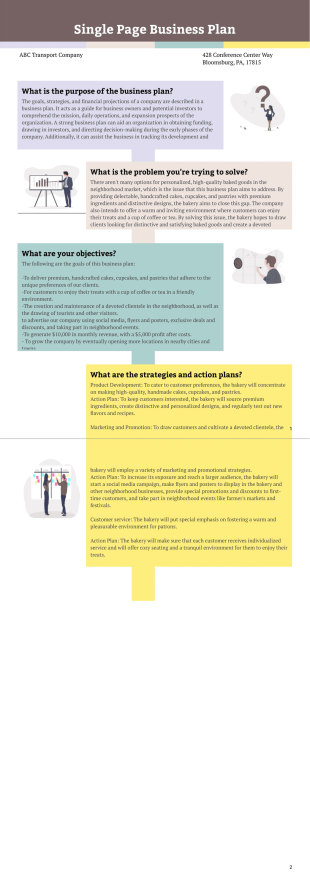
Single Page Business Plan
Get down to business with a customizable Single-Page Business Plan template from Jotform. Customize your plan in minutes. No coding. Drag and drop to build.

Operational Plan Template
This Operational Plan Sample is structured with important details for your organization. It comes ready to print, but you can simply edit the fields by putting your own organization information.
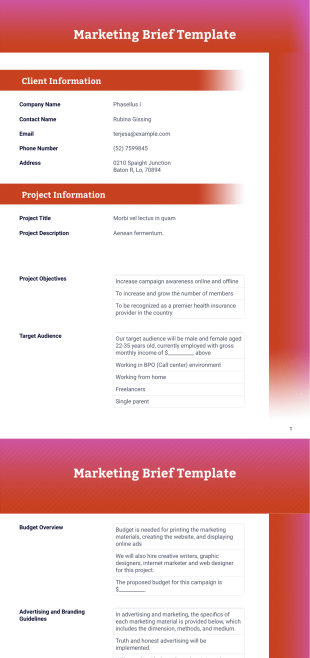
Marketing Brief Template
Managing a marketing campaign or promotion is a challenging task. You need to have a marketing plan in order to execute the campaign smoothly with the time and budget provided. Creating a Marketing Brief is very beneficial because it summarizes the marketing strategy for a specific campaign.If you are in the advertising agency or part of the marketing department, then this Marketing Creative Brief Template is for you. This well-designed template contains the client information, project information, and the marketing materials that will be used. The project details explain the project title, description, objectives, target audience, budget overview, advertising guidelines, and competitors.

Glamping Business Plan Template
Grab the attention of the investors by using this Glamping Business Plan Template. This business plan is simple yet effective because it contains all the necessary details when building a successful business.
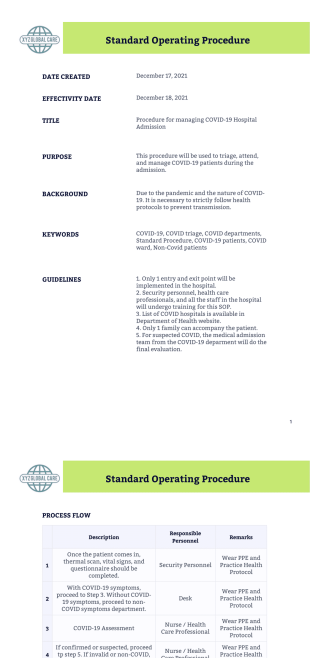
SOP Template
Create a process to organize your employees in managing specific cases or scenarios by using this SOP Template. This template is commonly used in any organization whether it is a small, medium, or large group.

Lean Business Model Canvas Template
See your business from a new perspective with Jotform’s Lean Business Model Canvas Template. Simply fill in a short form with problems your business could solve, how they are currently being solved in the market, and how your company can uniquely work to solve these problems. Our template instantly converts the information into polished PDFs you can download or print for your next big meeting.Our Lean Business Model Canvas Template already looks professional, but you can personalize it further to match your business. Jotform PDF Editor lets you rearrange form fields or add your company logo at the touch of a button! By instantly converting your business model into an accessible PDF format, our Lean Business Model Canvas Template can help you see the bigger picture and determine how to take your business to the next level.
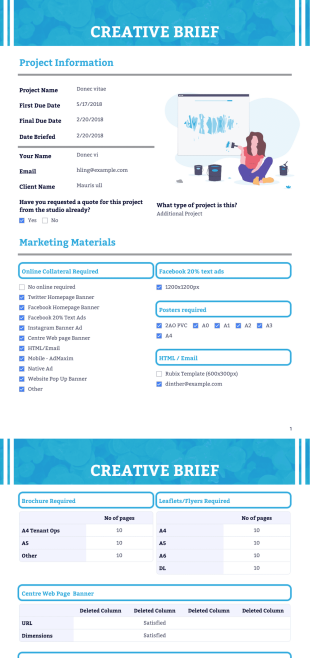
Creative Brief Template
A Creative Brief is used in advertising, branding, and marketing industries. In order to have a strong and outstanding creative campaign, you need to have a game plan to follow. This serves as a guideline that will help in making decisions related to the campaign.This Creative Brief Template PDF discusses the project details like the project name, due date, and project description. The marketing materials that will be used are listed in the document which includes its specifications like the dimension size, the medium that will be used, and the quantity. This is the best Creative Brief Template you can use for your next creative marketing campaign.

Business Model Canvas Template
Our Business Model Canvas Template includes nine segments which are key partners, key activities, value proposition, customer relations, customer segments, key resources, channels, cost structure, and pricing model.
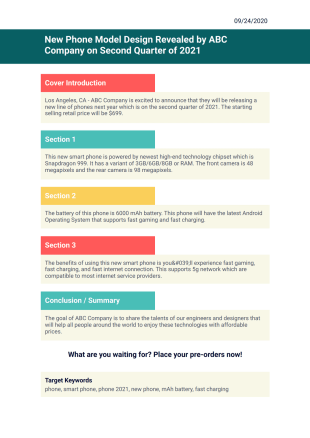
Blog Post Outline Template
Use this Blog Post Outline Template for your blog content in order to get more visitors, followers, shares, and impressions. This template will definitely help your ranking in search engines.
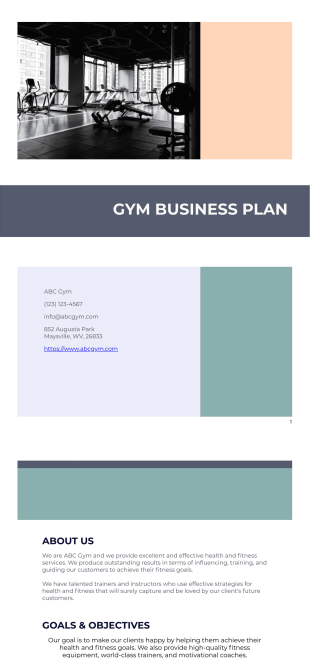
Gym Business Plan Template
Be successful in the gym business that you're building by securing funding or a loan with the help of this Gym Business Plan Template. This PDF can be printed and given to investors or loan applications.

Meeting Minutes Template
Set goals, plan your actions, and update your team members by tracking the team meetings by using this Meeting Minutes Template. This PDF template will surely help the team in terms of planning and productivity.

Pressure Washing Estimate Template
Create estimates for pressure washing services with the use of web tools. Use this Pressure Washing Estimate PDF template and create instant estimates in PDF format without the trouble of hiring programmers.
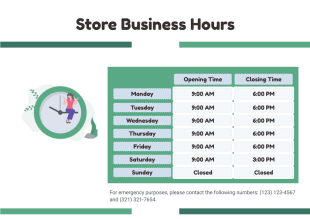
Business Hours Template
Announce and let the customers know if your business is open and not by using this Business Hours Template. This PDF template can be customized and personalized by using the PDF Editor.

Memorandum of Understanding Template
Build a harmonious relationship between two or more parties by using this Memorandum of Understanding Template. This template is easy to use and can be customized via the PDF Editor.

Scope of Work Template
Establish the responsibilities of the service provider by using this Scope of Work Template. This document will show the list of work and tasks that should be performed by the service provider.

Custom Sales Funnel Plan
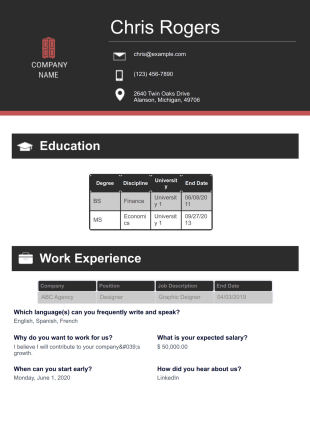
Curriculum Vitae
Curriculum Vitae Template will provide you with all the necessary information that you need for your recruitment procedure and automate the job application process of your business.
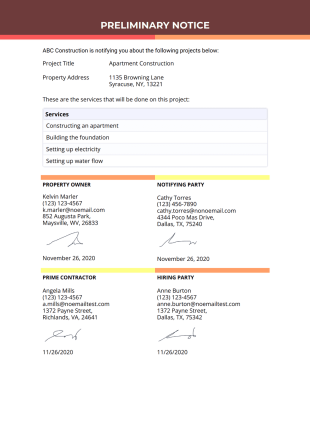
Preliminary Notice Template
Notify the parties involved like the property owner, hiring party, notifying party, and contractor about the construction project by using this Preliminary Notice Template. This PDF template can be customized if needed via the PDF Editor.

Credit Analysis

Retainer Agreement
Create retainer agreements online. Free, easy-to-customize template. Fill out on any device. Collect e-signatures. Save time with automation tools.
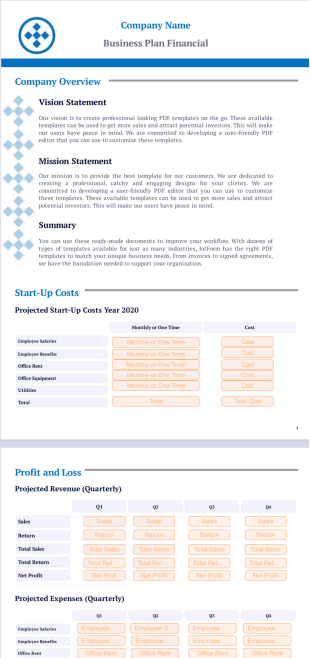
Business Plan Financial Template
Create a business plan financial template with Jotform Sign. Drag and drop to customize. Fill out and e-sign from any smartphone, tablet, or desktop.
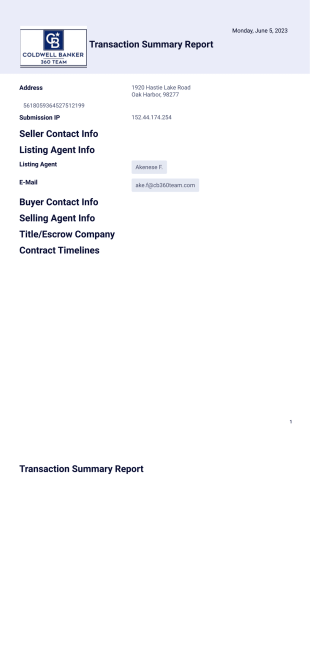
Transaction Summary

Employee Code of Conduct Template
Create a professional code of conduct to send to your employees. Can be signed from any smartphone, tablet, or computer. Easy to customize and share. No coding.
About Simple Business Plan Templates
Plans, strategies, roadmaps – Businesses rely on these things to gain perspective on what’s about to happen. Milestones laid down in strategic and careful planning for growth and expansion, visions of where the company’s headed 10 years from now, goals that should meet timelines, all these require a smart, prudent and calculated planning.
Whether you’re a startup, an SMB, or close to a Fortune 500, a solid business plan is crucial. And of course, writing business plans is a huge task. But, what if you needed something that requires input from others though? Say, an online form or a PDF template where responses from your colleagues and managers matter? Well, here’s a collection of PDF templates for business planning.
These are beautifully designed templates, specifically tailored for businesses and companies who don’t know where to start. The hard part was already done and that’s designing the template. These will serve as boilerplates for whatever milestone your business needs. You won’t need to worry on building something from scratch, you just need to focus on the content. Some of these templates will contain or collect executive summaries, opportunities, expectations, execution, financial plans, forecasts, the whole nine yards.
Business plan templates help give a clear vision of what lies ahead. They help you get things organized, planned out, and help you check off items from your to-do list more efficiently.
Frequently Asked Questions
1) what are the seven parts of a business plan.
- Executive summary. This is an overview of your business plan. The executive summary should include your company’s offerings, mission, goals, and projections. Think of it as the elevator pitch for your business plan. If you can’t get investors interested here, it’s unlikely they’ll want to keep reading.
- Company description and history. Describe your business’s legal structure and history in addition to what you do. If you just started this business, you may replace company history with your leadership team’s experience. The purpose of this section is to explain the company structure and build confidence in the people running the company.
- Products and services. Talk about what your company offers, whether that’s products, services, or a combination of the two. Describe your products and services in detail. Explain what makes your offering unique, what your profit margins are, what kind of demand you’re seeing for it, etc.
- Market and competitor research. Investors want to know if there’s demand for your offering. Describe the target market and how your product or service benefits potential customers. Include projections of where the industry is headed over the next few years. Additionally, detail your competitors and how saturated the market is.
- Sales and marketing strategy. This part of the business plan explains how you’ll promote your product. Outline elements such as your ideal customer profile (ICP) as well as your marketing channels, budget, and methods.
- Operations and logistics. Explain how you’ll source materials if you sell products as well as the technology you need to deliver such products and services. Also, provide details about your team, like how many people you’ll need and how you’ll manage employees.
- Financial plan and projections. It’s crucial to prove that your business will be financially viable. For this, you’ll need revenue and expense projections. Many investors want to see sample account statements, balance sheets, and cash flow projections.
2) How do you write a business plan?
Your business plan should be a realistic roadmap that helps you build a successful company. When writing it, take a balanced approach so that you’re not blind to the potential pitfalls and risks. You’ll draft each of the seven sections previously discussed.
Tackling these sections can be overwhelming, so some people like to start with a one-page business plan that includes short paragraphs for each element. Another way to give yourself a head start is by working from a business plan template. Once you have a good start, you can expand each section to make a compelling case for your business.
3) Can I write a business plan myself?
Yes, you can. However, depending on your writing experience and goals, you may want outside help. If the business plan is for internal use with the purpose of improving business functions, you’ll likely be OK tackling it alone. But if you’re trying to secure funding from a bank or investors, a professional business plan writer can give you a leg up.
Even if you decide to do it yourself, have a trusted friend or business mentor review your plan and provide feedback. An objective point of view will help you refine your work.
4) What are the four types of business plans?
- One-page or mini business plan. The one-page option is a great way to improve the focus of your business plan and highlight the essential elements. It can be an effective way to workshop your company’s plan or quickly give others a rundown of your entire business.
- Traditional business plan. The traditional business plan is more in-depth than its one-page counterpart and will be more thorough in each section (often, plans exceed 40 pages). For example, it may contain detailed financials, branding samples, and competitive research documents.
- Business model canvas (BMC). The business model canvas is a more visual representation of your business architecture. It includes sections for infrastructure, offering, customers, finances, etc. Many businesses find the BMC appealing since it can be summarized in a single page.
- Strategic business plan. The strategic business plan can have different purposes, like proving feasibility, discussing planning operations, or projecting growth. It will outline the company’s goals, its strategy for reaching them, and the company structure. The main difference between this and the traditional plan is its focus on specific strategic initiatives.
5) What are the common mistakes in business plans?
- Poor writing. Sloppy writing may suggest that you’re not serious about your business or you lack the needed professionalism.
- Unrealistic expectations. While you should be optimistic about your business, if your financial projections reflect your hopes more than reality, people may hesitate to back your business.
- Lack of supporting documentation. People reviewing your business plan want to see how you back up your claims. You can include research docs, sample financials, and estimates to make your case.
- Failing to define the target audience. For a successful marketing plan, you need to define your target audience. Investors and financial institutions need to see if you’re confident about who you’re selling to.
- Unbalanced. It’s important to lay out the risks and potential upsides. This analysis shows investors that you’re considering the whole picture regarding your business.
These templates are suggested forms only. If you're using a form as a contract, or to gather personal (or personal health) info, or for some other purpose with legal implications, we recommend that you do your homework to ensure you are complying with applicable laws and that you consult an attorney before relying on any particular form.
Access our library of 130 Business Templates
Wow you’ve unlocked access to our library of 130 business templates.
Get started by checking out some of our top business templates:
Featured business templates
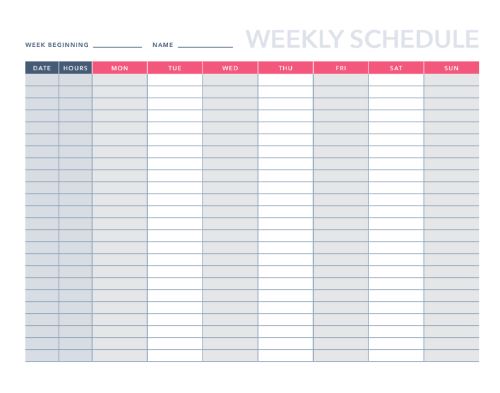
Weekly Schedule Template
Tracking employees’ work time and wages is easy with this free weekly schedule template.
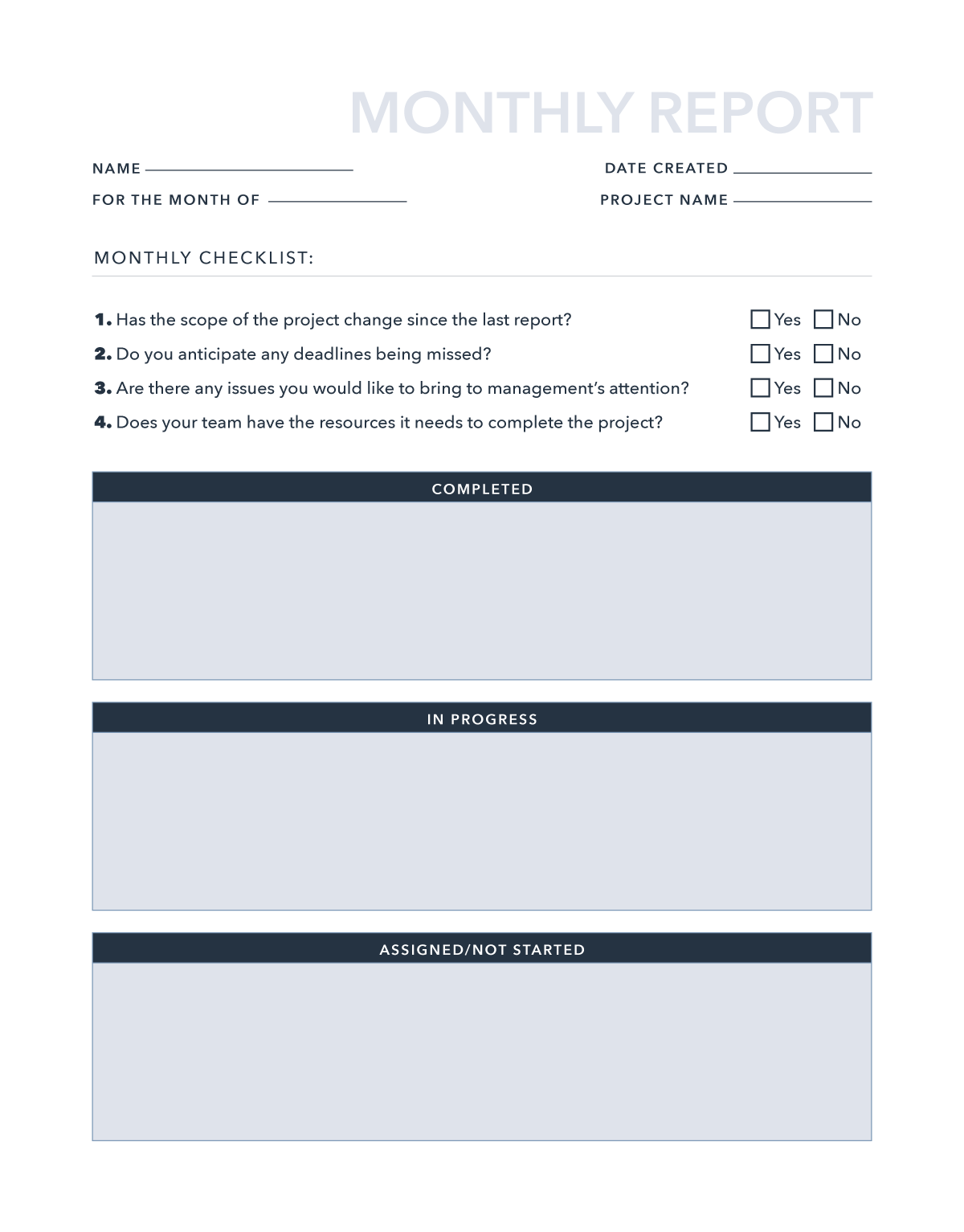
Monthly Report
Provide a professional, concise summary of project activities with this monthly report template.

One Page Business Plan
Need to write a business plan but don’t know where to begin? Download our free 1-page business plan ...
6 Free Business Plans | PDF Templates & Examples
All business plans | pdf business templates..
Showing 1 - 6 of 6
.png)
Business Case

Executive Summary Template

Simple Business Plan Template

Startup Business Plan Template
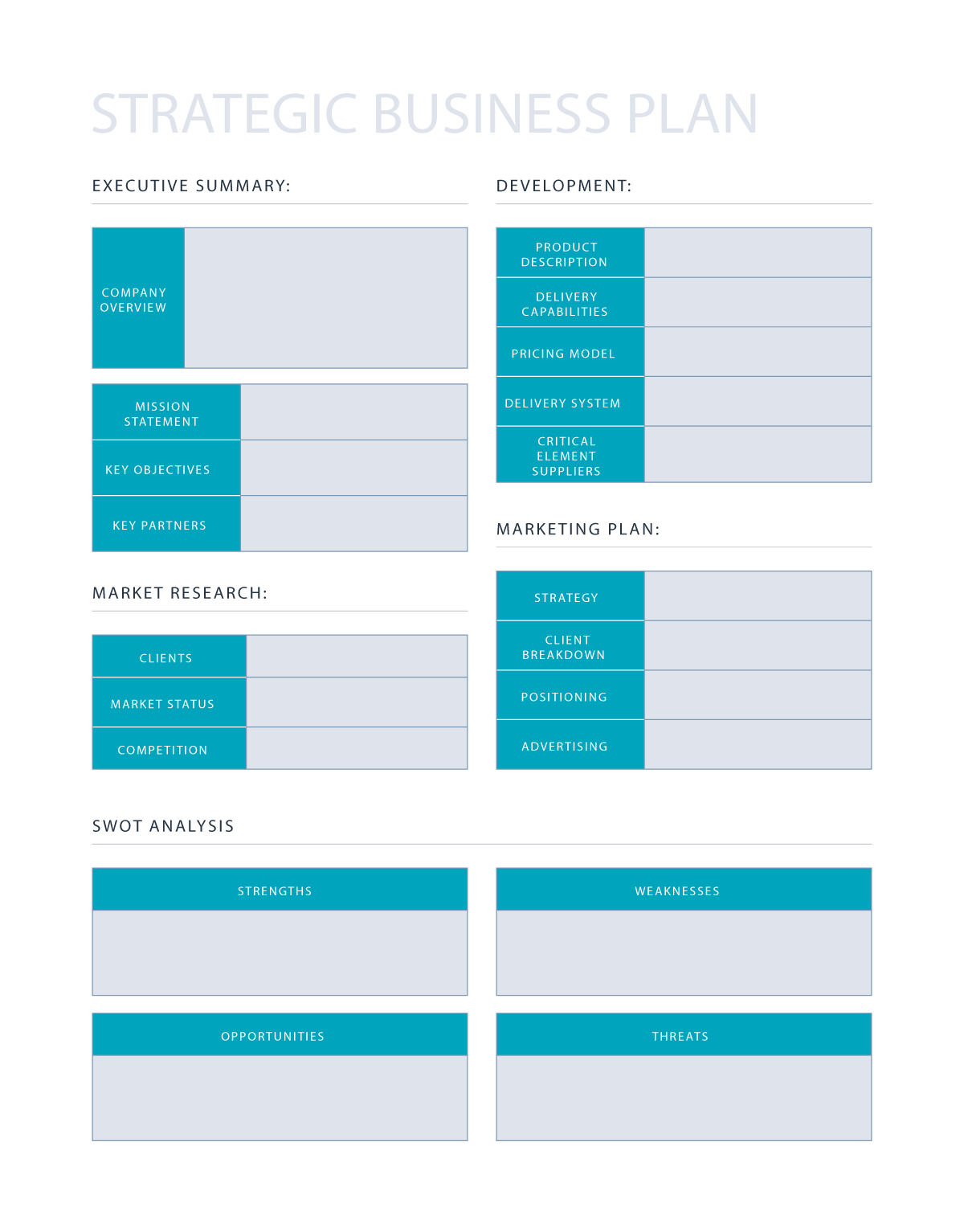
Strategic Planning
Explore template collections.

Customer Service

Spreadsheets

Get all Business Plans | PDF templates and more.
Business Plan Templates
Free Download
.png)
2 Essential Templates For Starting Your Business. Available as an interactive PDF or a Google Docs template.
With this business plan template, you'll be able to:
- Write a company description that sells your story
- Plan for the future: lay out goals and metrics for success
- Describe your product line in detail and plan for how to stand out from competitors
- Consider any legal formalities that require attention when starting your business
- Put together necessary financial projections to make a strong start
- Create your buyer persona and determine your product/marketing fit

Build A Business Plan That Works
Available as a one-page interactive PDF and a full template on both Google Docs and Microsoft Word!
Whether you’re starting a business or drafting a formalized document with your current business goals, it’s important to clearly defi ne the scope of all aspects of the venture — from mission, to target customers, to fi nances, and beyond.
When just starting out, it can be tempting to think of a business plan as simply your company’s name and a description of your product or service. But in reality, planning a business involves thinking through a lot more details.
In this business plan template we’ll guide you through the steps of writing company and product descriptions, setting sales and marketing goals and plans, and thinking through legal and fi nancial logistics. We've included a plain text, designed , and completed example version of this template.
Frequently Asked Questions (FAQs)
How do you write a business plan.
A business plan is a formal written document that you can use to identify the purpose of your company, make important decisions about your future and help grow your company. HubSpot's free business plan templates provides guidance to establishing your company mission, customer research, competition, and a business strategy to profitability.
Why do I need to fill out the information requested?
We will always keep your personal information safe..
We ask for your information in exchange for a valuable resource in order to (a) improve your browsing experience by personalizing the HubSpot site to your needs; (b) send information to you that we think may be of interest to you by email or other means; (c) send you marketing communications that we think may be of value to you. You can read more about our privacy policy here .
Where can I get a free business plan template?
HubSpot's Free Business Plan Templates are the best way to create a professional, thorough business plan. The templates include instructions and everything you need to know about starting your company.
Is this really free?
Absolutely.
Just sharing some free knowledge that we hope you’ll find useful. Keep us in mind next time you have marketing questions!
What are the basic format of a business plan?
A business plan is a written document that outlines the company's goals, strategy and implementation. The format of the plan varies depending on the type of organization (e.g., for-profit or nonprofit) and size, but most plans share some common features such as an overview, executive summary, and financial information.
What is the best business plan template?
A great business plan template clearly defines the scope of the venture -- from mission, to target customers, to finances, and beyond. HubSpot's business plan template will guide you through the steps of writing company and product descriptions, setting sales and marketing goals and plans, and thinking through legal and financial logistics.
What is needed to start a business?
If you're thinking about starting a business, you'll need to do some research first. You can't just start a business without doing any market research. Market research will tell you if there's an opportunity to turn your idea into a successful business. After that, write your business plan so that you know how much money and time it will take for the project to succeed. Use HubSpot's free business plan template today!
Set yourself up for success with this business plan template
Download the free business plan template.
All fields are required.
Easily create great, effective landing pages for free
400+ Business Plan Examples to Launch Your Business

Select your Business Category

IT, Staffing & Customer Service (16)

Construction, Architecture & Engineering (17)


Food, Beverage & Restaurant (57)

Real Estate & Rentals (16)

Mobile Apps & Software (6)

Education & Training (14)

Beauty Salon & Fitness (19)

Medical & Health Care (39)

Retail, Consumers & E-commerce (80)

Entertainment & Media (43)

Transportation, Logistics & Travel (26)

Agriculture, Farm & Food Production (18)

Nonprofit & Community (9)

Manufacturing & Wholesale (33)

Services (213)

Clothing & Fashion (12)

Children & Pets (16)

Fine Art & Crafts (5)

Cleaning, Maintenance & Repair (22)

Hotel & Lodging (9)

Finance & Investing (13)

Consulting, Advertising & Marketing (22)

Accounting, Insurance & Compliance (5)
Didn't find what you are looking for.
Writing a business plan from scratch seems like an uphill climb? We get that, but hold tight—you’re not alone. Even business plan writers often feel the same way while writing from scratch. That’s where a little content reference or inspiration can help—just like these business plan examples .
Reading such real-life sample business plans can be incredibly helpful while drafting your very first business plan with zero clue about business plan writing.
As you read and explore these industry-specific examples, you learn more about what you should and should not include in your business plan, ensuring sustainable and long-term growth.
So, let’s explore these 400+ business plan examples to help you quickly write a business plan—hassle-free.
Why you should refer a business plan example?

A Business plan example will provide you with the complete format and structure for your document, giving you a head start on developing your document so you’re not stuck seeing an empty page working to find out where to start.
Also, it gives you the overall layout of a professional business plan so you understand what goes where and you’re not leaving out anything.
Here are some of the key benefits of using sample business plans:
- Guidance on what to include in each section. If you’ve never attended business school, you might never have created a SWOT analysis or a balance sheet before. Business templates that give guidance — in plain language — about what to include and how to fill in each section and create a complete and effective plan.
- A business plan is vital to get an investment. If you’re seeking investment for your business, you’ll need to convince banks and investors why they should invest in your business. Lenders and investors will only risk their time and money if they’re certain that your business will be successful and profitable and they will get a great return on their investment.
- A business plan can help you prioritize. A complete, well-balanced business plan is one of the most valuable tools in assisting you to reach your long-term goals. It gives your business direction, defines your goals, outlines out strategies to reach your goals, and helps you to manage possible bumps in the way.
Creating a business plan will help you define the business goals you want to achieve, and define the strategies to achieve them. This means you can focus your resources and energy on what is important, rather than wasting time on unimportant things.
If you’re working with a team in your company then having a regular brainstorming session is the best way to keep your business on track and your business plan assures you’re all on the same page.
Make your plan in half the time & twice the impact with Upmetrics.

Sample business plan format
Following is the standard business plan format you must consider while drafting a comprehensive business plan.
- Executive Summary : A high-level overview of your business plan.
- Company Overview : An in-depth and detailed description of your small business, its fundamental elements, and future goals.
- Market Analysis : A detailed description of your industry with the target market, competitors, and growth potential.
- Products and Services : Description of the products or services you intend to exchange for money.
- Sales and Marketing Strategies : Promotional strategies you will use to attract and retain customers.
- Operations Plan : Business processes and procedures that ensure seamless business operations.
- Management Team : Introduction to your founders, key management, and their compensation plan.
- Financial Plan : A breakdown of your financial projections and financing needs.
- Appendix : A supplementary final section that includes additional documents to support your plan.
This was about the outline. Now let’s break down and understand how to write each section, step by step, with real-life examples.
1. Executive Summary
Executive Summary is the first section of your business plan, providing a high-level overview of your entire plan and summarizing it for a quick understanding of your business.
Considering it as an introductory section of your plan, it must be clear, concise, and written to grab readers’ attention and persuade them to take action.
As business plans can be 10-20 to a hundred-page long, an executive summary remains your sole chance to gain a quick extra point.
Here are a few key components your Executive Summary must include:
- Business concept
- Company’s mission
- Company History
- Market Opportunity
- Management Team
- Financial Projections
Remember, you are bound to cover these topics in detail moving forward in your business plan, so make sure your executive summary is brief, covering only the key takeaways.
2. Company Overview
As the name suggests, the Company Overview section of your plan provides an overview of your small business, including your business concept, objectives, future goals, and what customers your business serves.
Since you will provide a brief company description in the executive summary, this section will expand on it—providing an in-depth understanding of your business.
Remember, this section is a platform for introducing and positioning your business as an ideal solution for your target market to your reader. So, make sure it’s short and succinct but impactful enough to help them understand what it does, who your potential customers are, and how you can make a difference.
Here are a few key components your business overview must include:
- Company Description
- Mission Statement
- Business Objectives
- Business History
- Future Goals
3. Market Analysis
Market Analysis is a study of your external business environment, providing a complete overview of your industry and its dynamics. This section provides valuable insights into the market, like what’s working.
When smartly researched, utilized, and written, this section can help you discover and identify untapped areas in the market and strategize to stand out from your competitors.
Remember, this section helps your readers and potential investors understand your target market, market size, and growth potential, so make sure you play your cards right.
Here are a few key components your market analysis section must include:
- Target Market
- Market Size and Growth Potential
- Competitive Analysis
- Market or Industry Trends
- Regulatory Environment
Unlike other sections of your business plan , Market Analysis requires deep research and analytical work. However, using an industry-specific example business plan can save hours of research work.
4. Products And Services
The products and services section is where you will mention and elaborate on your product or service range, description, pricing strategies, and more.
Since your business success solely depends on your products or services, your entire plan revolves around this particular section.
This section can be a crucial component of your plan while searching for an investor or partner, as a well-articulated products and services section can help you persuade them.
Here are a few key elements your products and services section must include:
- Product Description
- Product Comparison
- Pricing Strategy
- Order Management
- Quality Measures
5. Sales And Marketing Strategies
A business’s sales and marketing strategies determine how your product is displayed and reaches your target audience.
A well-designed sales and marketing plan can help you streamline your marketing efforts and create impactful and effective marketing campaigns while keeping track of the marketing budget and maximizing return on investment.
In short, this section will discuss how you’ll acquire new customers using your sales and marketing strategy. You might consider including the following information in your sales and marketing plan:
- Your target audience and brand positioning
- Your business’ UVP
- Marketing channels and distribution tactics you plan to use
- Sales goals and performance measurement
- Your customer retention strategies
- Your sales and marketing goals
6. Operations Plan
The operations plan section outlines the daily business processes and activities centered on achieving business goals and objectives described in the previous sections of your plan.
A detail-oriented logistics and operations plan helps you and your team define your responsibilities, daily tasks, and short-term goals you need to achieve, keeping track of your long-term objective.
Remember, your logistics and operations plan won’t be static but a living document. You may adjust and update it as time goes on.
Here are a few key elements your operations plan section must include:
- Staffing and training
- Tools and equipment
- Inventory management
- Supply chain management
- Operational process
7. Management Team
Your management team plays a crucial role in the ultimate success of your business. And this section introduces your owners and management team, along with their qualifications, industry experience, roles and responsibilities, and compensation plan.
A strong management team section can be critical to weigh authority and help investors be confident about your business idea and vision.
Make sure to include the educational background, accomplishments, work experience, and area of expertise for each individual, part of your management.
You might consider including the following information in the management team section:
- Business owner/founders
- Key management
- Organization structure
- Compensation plan
- Advisors/consultants
8. Financial Plan
It’s no secret that the financial plan is the most crucial yet nerve-wracking aspect of business planning. In fact, it’s one of the deciding factors when it comes to convincing potential investors and banks to invest or lend money.
This section of your plan details your business’s financial information and how it will reach its financial goals. The information may include balance sheet, income, and cash flow statements.
Here are a few key components and financial statements you must include or provide while creating a financial plan:
- Profit and loss statements
- Operating costs
- Income statement
- Cash flow statement
- Balance sheet
- Break-even point
- Financing needs
9. Appendix
While an Appendix isn’t a required element of your business plan, it can be pretty helpful in adding legal notes, charts, tables, or any other critical information to support your business document.
It generally includes financial statements, information, and documents that didn’t naturally fit into your plan but can be considered critical enough to add.
In addition, it helps readers navigate through the entire business plan and easily find specific information or documents.

Need a way out from manual editing and business plan writing work?
Get Upmetrics’ business plan template, import data directly into the editor, and start editing using Upmetrics AI Assistant.
Start Planning Now
Since we are finished discussing the sections of a business, let’s learn more about how you can put an example business plan to use while writing your own.
How to use an Example of a Business Plan to write your own?
Having real-life and industry-specific business plan examples by your side can be incredibly resourceful to help you write a business plan from scratch.
A well-planned structure helps you outline your plan, while content inspiration helps you set the tone for your business document.
Let’s dive deep and understand how to use these examples effectively to write your business plan.
1. Understanding the Structure
Traditional business plans generally follow a similar structure.
It starts with an executive summary followed by a company description, market analysis, product and services, sales and marketing strategies, operational plan, management team, financial plan, and appendix.
Using an example business plan is the best way to understand the structure and outline your plan.
2. Gaining Inspiration
Reading industry-specific business plan examples can help you gain inspiration for your plan. You can gain insights on presenting your business idea, vision, mission, and values and persuade investors to invest in your idea.
3. Learning Industry-Specific Language
There’s no universal template for business planning that fits all. An industry-specific template can help you learn and understand the business language for your industry and the best way to communicate your message to your investors.
4. Identifying Key Elements
Reading business plan examples of similar businesses can help you identify the key elements and information to include in your plan. You can keep note of these and ensure everything necessary for investors to consider is present in your final draft.
5. Crafting Financial Projections
A financial plan is a critical component of your business plan, and a good business plan example can help you better understand how they project their financials which can be incredibly helpful while forecasting yours.
6. Refining Your Executive Summary
As mentioned earlier, your executive summary is a key factor influencing potential investors and lenders to invest or lend you money. Analyzing free business plan templates can help you optimize your executive summary to make it more brief, persuasive, and attention-grabbing.
7. Realizing what works and what doesn’t
Analyzing industry-specific and real-life examples can help you determine what works best and what doesn’t within your industry. Understanding these factors can help you avoid many significant pitfalls.
While business plan examples can be incredibly helpful in writing a plan from scratch, ensure your plan is customized for your business and sends out a unique message. Your business plan must reflect its unique idea, vision, and target market.
Download business plan examples for:
- Business Plan Template for Startups
- Business Plan Template for Small Business
- Business Plan Example for Non Profits
- Business Plan Example for Students
Download a free sample business plan template
Ready to kick-start your business plan writing process? Not sure where to start? Here you go, download our free sample business plan, import data directly into the editor, and start planning.
This intuitive, modern, and investment-ready template is designed specifically for startups and small businesses. In fact, this format has helped 110K+ entrepreneurs create business plans to secure funding, business grants, and loans. It includes a business planning course and step-by-step instructions to write each section.
Business plan types: choose the suitable template
Well, there are a few types of business plans. Though they cover similar categories, they all have different formats intended for different purposes or industries.
Here are a few common business plan types to help you choose the most suitable one for your business:
1. One-page business plan
One page business plan can be considered a one-page version of a standard business plan. It’s mainly used to present a quick overview of small businesses to your vendors, employees, investors, or stakeholders.
Considering its shorter length, creating a one page business plan can be a lot easier and less time-consuming compared to a standard business plan using a business plan software like Upmetrics.
2. Lean business plan
A lean business plan is a summarized version of a standard business plan that is longer than a one-page one. It’s mainly used to track finances and emphasize achieving short-term milestones.
This business plan type is best suitable if you are unsure about the business planning process. Moreover, drafting a lean business plan is also a lot easier and faster than a standard one.
3. Traditional business plan
A traditional business plan is the standard plan entrepreneurs have been using for years to outline marketing strategies, project financials, and draw investors. A traditional business plan can be a few dozen to a hundred-page long, depending on its purpose and your business specifications.
A traditional plan is a must-have business document for business owners aiming to achieve long-term business success.
4. Internal business plan
As the name suggests, an internal business plan is a document designed for internal management and team members to ensure everyone’s on the same page. The primary focus of these plans is to set primary goals and outline processes aiming to achieve them—ultimately streamlining business operations.
Start writing your business plan
There’s no denying—creating a business plan that draws investors in needs some serious work; it’s no stroll in the park. But you must take the first step to stay ahead in the cut-throat competition; there is no way around it.
So, what are you waiting for? Understand your business and the value it offers to its customers, find a suitable template from our library, and start planning.

Simplifying Business Planning through AI-Powered Insights.

Founder, CEO & Lead Scientist at Nanolyse Technologies
After trying Upmetrics, I wish to highly recommend this app to anyone who needs to write a business plan flexibly and to a high standard.
Frequently Asked Questions
How can i write my own business plan.
Follow this step-by-step process to write your business plan on your own.
- Choose a format that best suits your business requirements
- Create a business plan outline
- Create a company description section
- Conduct market research
- Conduct a competitive analysis
- Describe your product and services
- Outline sales and marketing strategies
- Create a logistics and operations plan
- Introduce management team
- Project financials
- Summarize your plan with an executive summary
- Complete your plan with an appendix
Where can I find business plan examples?
Upmetrics is an incredible business planning solution providing 400+ business plan samples and examples. You can easily create a good business plan using these industry-specific templates.
What is a business plan template?
A business plan template is a pre-formatted business plan, usually written for a fictional company. These industry-specific templates can help entrepreneurs understand a business plan’s structure and other key components. These templates are used mainly by entrepreneurs planning to launch a new startup or expand an existing business.
Should I hire someone to write my business plan for me?
Concept, contents, and cashflow are the 3Cs of a business plan that can be defined as follows:
- Concept: Your concept should explain the purpose of your business, summarizing what you plan to accomplish with this very business.
- Contents: Your content should reflect your concept, product and services, target market, and competition.
- Cashflow: Your cash flow section must detail your cash in-and-out flows, including capital investment, operations costs, and revenue projections.
Why Is It Beneficial to Use a Sample Business Plan as a Guide?
Let’s face it—writing a 40-50 page business plan from scratch can be too intimidating; you may soon give up and won’t even finish it.
Instead, using a sample business plan as a guide can help you understand its structure, gain inspiration and ideas for content, plan marketing strategies, and project financials. In short, using business template examples is the best way to write a business plan.
When should you not follow a business plan example?
We’ve always been saying this, using an example of a business plan is the best way to write one. However, it’s also critical to understand when not to follow a template. Here’s when:
- The format does not align with your business model or industry.
- Include outdated templates and information.
- Offer poorly written content.
- Include misleading and poorly done financials.
- There’s a lack of expertise.
These are a few red flags in a template you must consider looking at while choosing one.
Are these examples suited for business plan beginners?
Absolutely. In fact, these examples are specially designed, keeping common issues faced by beginners while drafting a plan in mind to serve them best. So, if you are a new or an established business with no planning experience, you have to check out these templates.
Looking for a faster way to finish your business plan?
We're very sorry however an error has occurred with your last request.
For For International Customers 01539 741 478
Thank you for your patience
Free Small Business Plan Templates and Examples
By Kate Eby | April 27, 2022
- Share on Facebook
- Share on LinkedIn
Link copied
We’ve compiled the most useful collection of free small business plan templates for entrepreneurs, project managers, development teams, investors, and other stakeholders, as well as a list of useful tips for filling out a small business template.
Included on this page, you’ll find a simple small business template and a one-page small business plan template . You can also download a fill-in-the-blank small business plan template , and a sample small business plan template to get started.
Small Business Plan Template
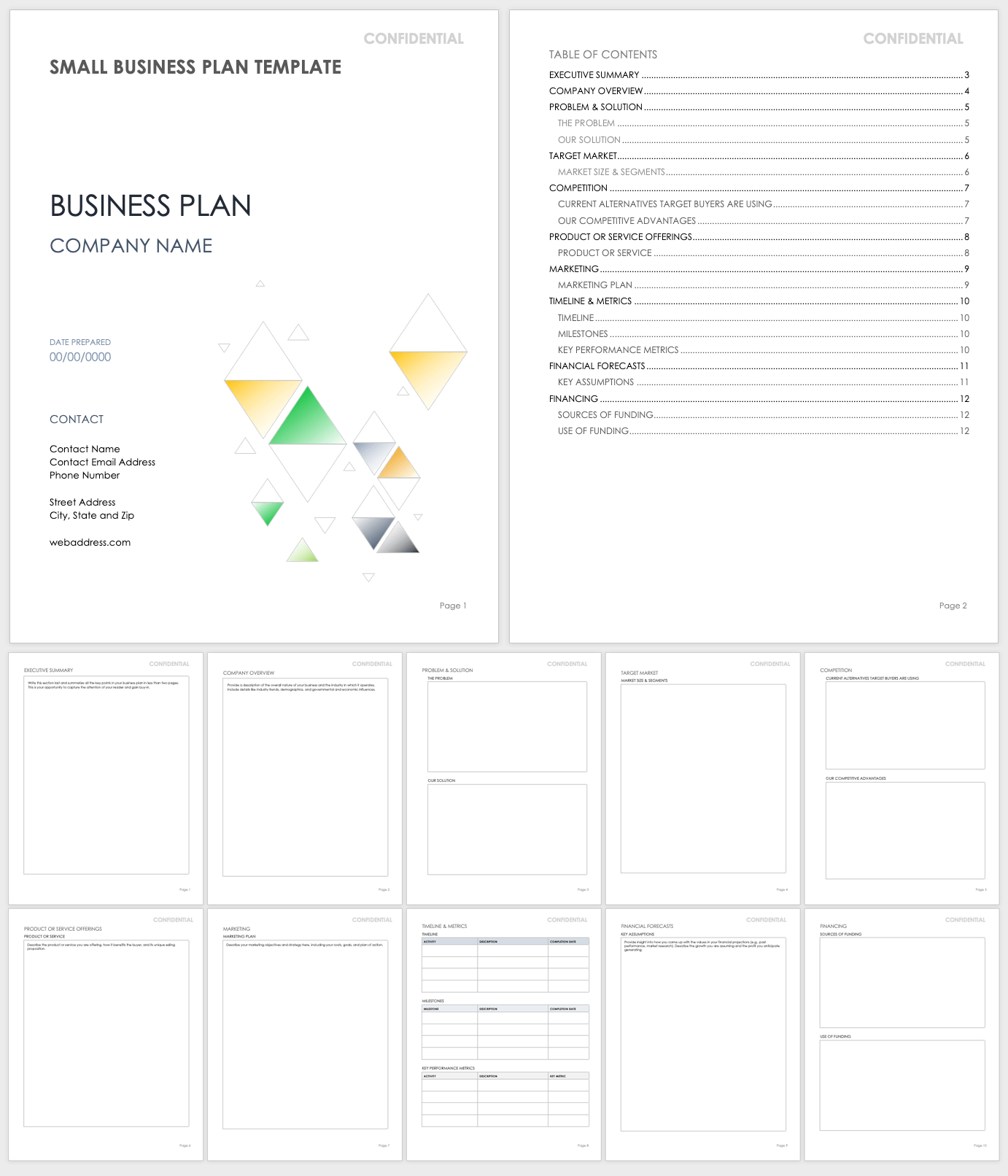
Download Small Business Plan Template Microsoft Word | Adobe PDF | Google Docs
Use this small business plan template to identify trends and demographics in the company overview. Highlight how your product or service uniquely benefits consumers in the offerings section, and note your proposed timeline, milestones, and the key performance metrics (KPIs) you will use to measure your success. This template has all the components of a standard business plan, from the executive summary through financing details.
Small Business Plan Sample Template
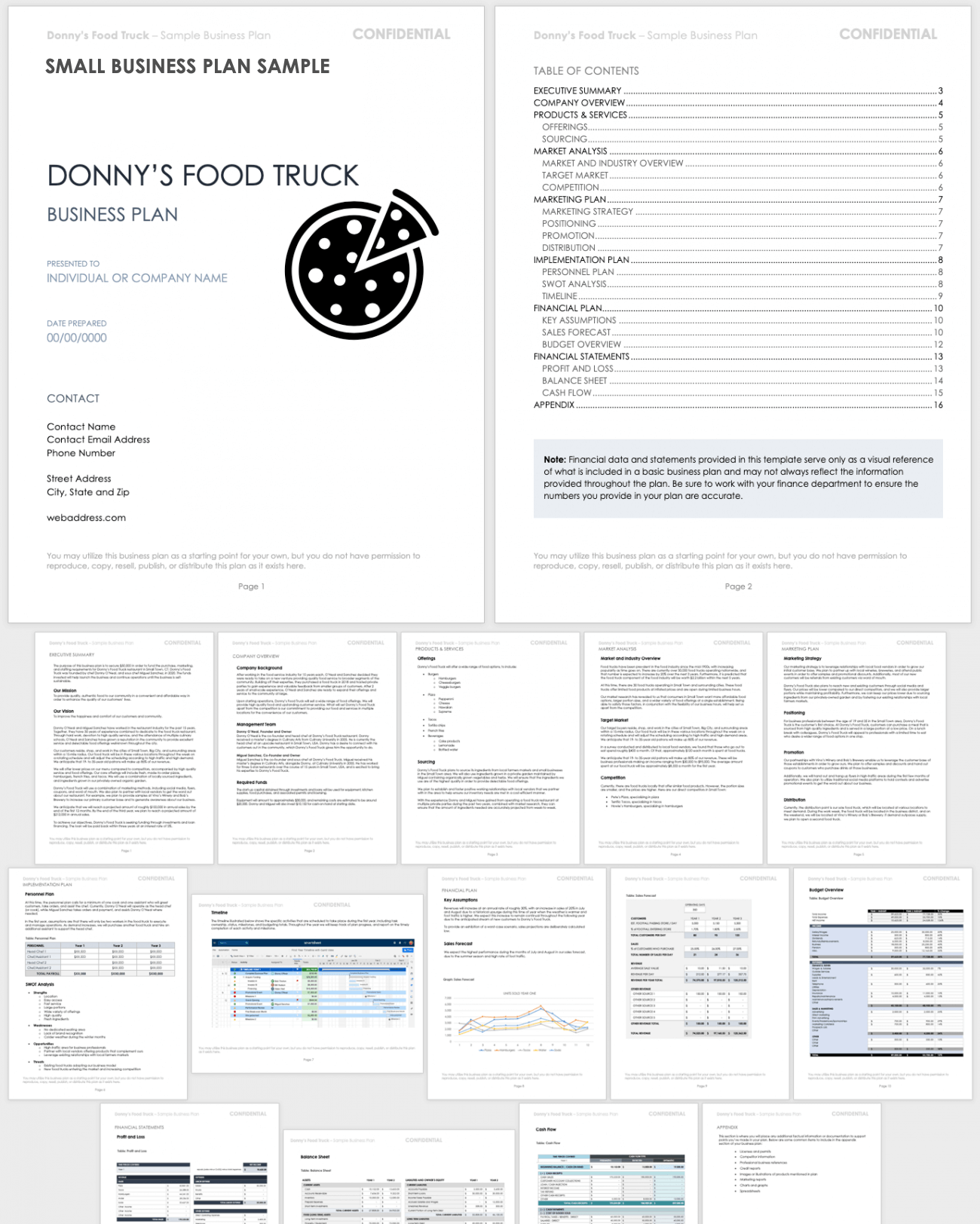
Download Small Business Plan Sample Microsoft Word | Adobe PDF | Google Docs
Use this small business plan sample template to draft the subsections and headings of the contents of your plan. This template provides editable sample text that shows you how to organize and create a ready-to-be-implemented business plan. This sample template helps remove the guesswork of what to include in a small business plan.
Simple Small Business Plan Template

Download Simple Small Business Plan Template Microsoft Word | Adobe PDF
Use this streamlined, customizable, simple small business plan template to chart revenue, expenses, and net profit or loss forecasts with sample graphics. Order your small business plan with numbered subsections and list them in a table of contents. Supplement the plan with additional information in the appendix for a complete business plan that you can present to investors.
Small Business Plan Chart Template
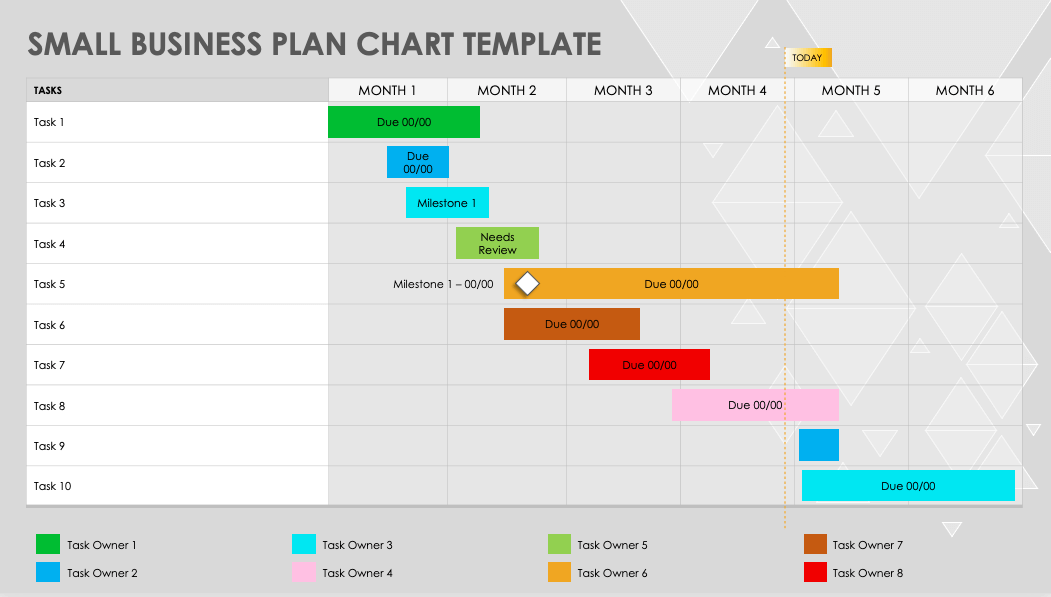
Download Small Business Plan Chart Template Microsoft PowerPoint | Google Slides
Use this small business plan chart template to plan and track month-by-month and annual business planning. The flexible color-coded bar chart simplifies tracking and allows you to customize the plan to meet your needs. Add tasks, track owner status, and adjust the timeline to chart your progress with this dynamic, visually rich small business planning tool.
Small Business Plan Outline Template

Download Small Business Plan Outline Template Microsoft Word | Adobe PDF | Google Docs
Use this small business plan outline template to jumpstart a plan for your small business. This template includes the nine essential elements of a traditional business plan, plus a title page, a table of contents, and an appendix to ensure that your document is complete, comprehensive, and in order. Easily simplify or expand the outline to meet your company’s needs.
Printable Small Business Plan Template
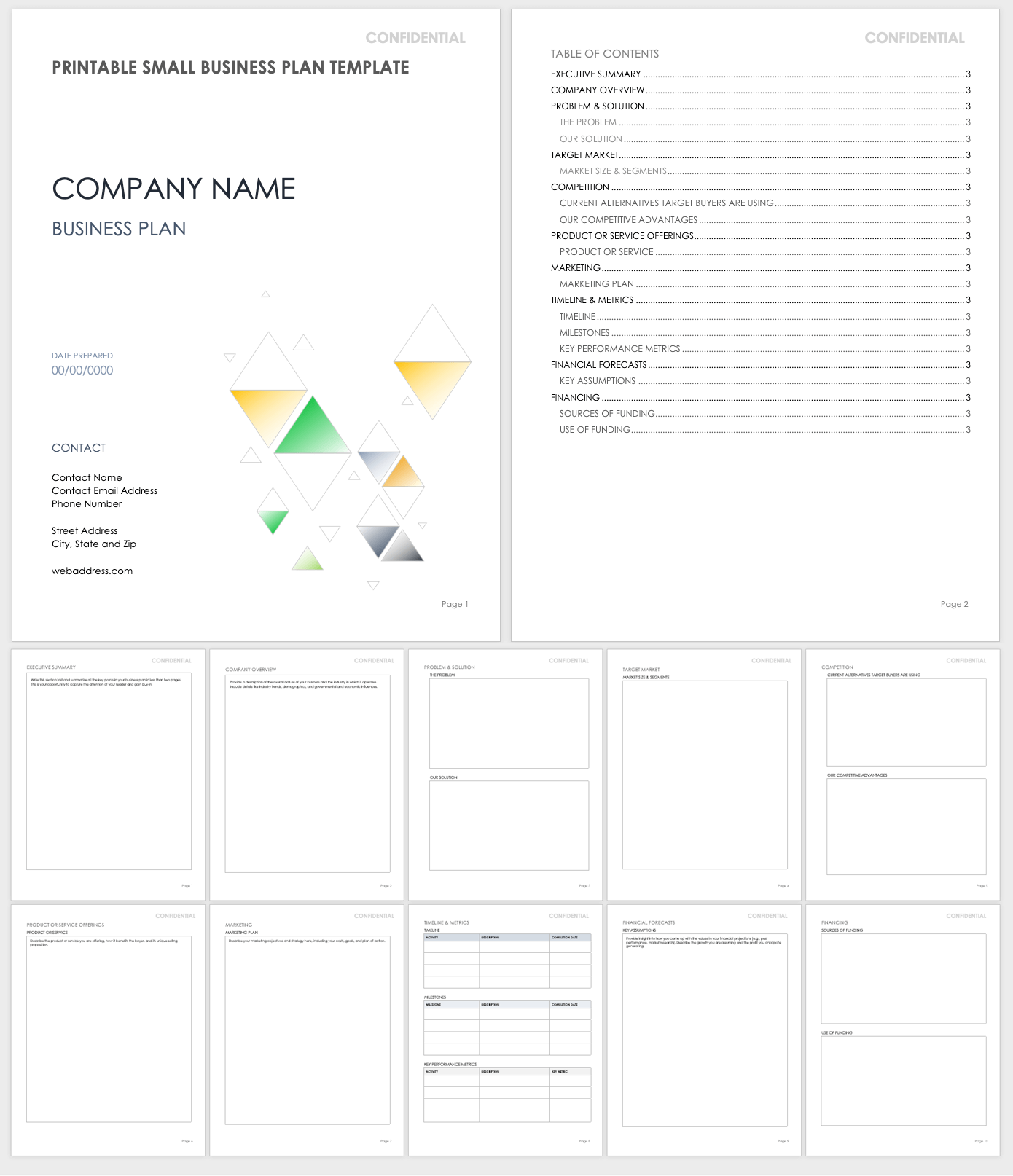
Download Printable Small Business Plan Template Microsoft Word | Adobe PDF | Google Docs
This print-friendly small business plan template is ideal for presentations to investors and stakeholders. The customizable template includes all the standard, critical business plan elements, and serves as a guide for writing a complete and comprehensive plan. Easily edit and add content to this printable template, so you can focus on executing the small business plan.
Small Business Startup Plan Template
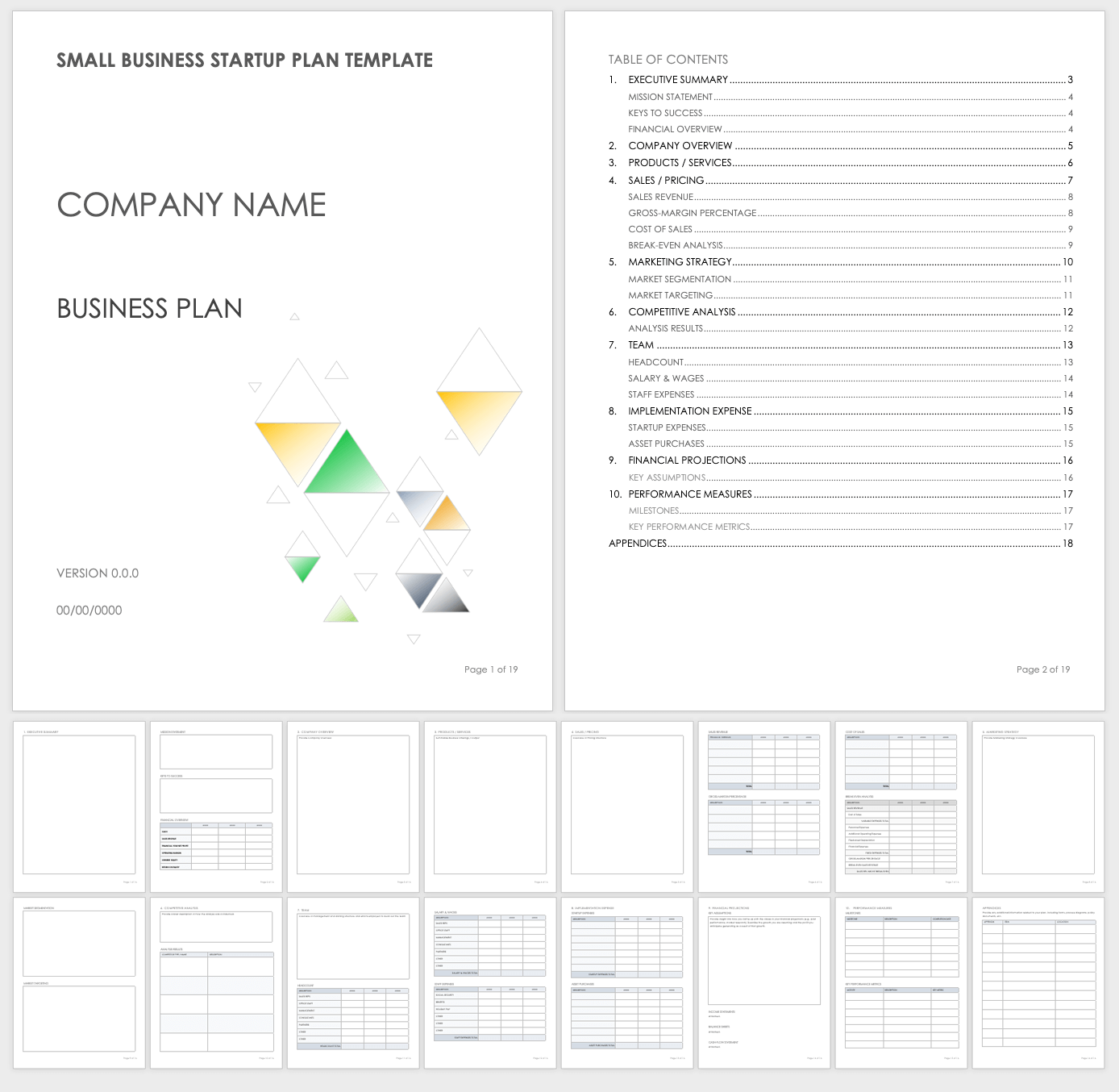
Download Small Business Startup Plan Template Microsoft Word | Adobe PDF | Google Docs
Use this small business startup plan template to draft your mission statement and list your keys to business success, in order to persuade investors and inform stakeholders. Customize your startup plan with fillable tables for sales revenue, gross profit margin, and cost of sales projections to secure your business's pricing structure.
Fill-in-the-Blank Small Business Plan Template
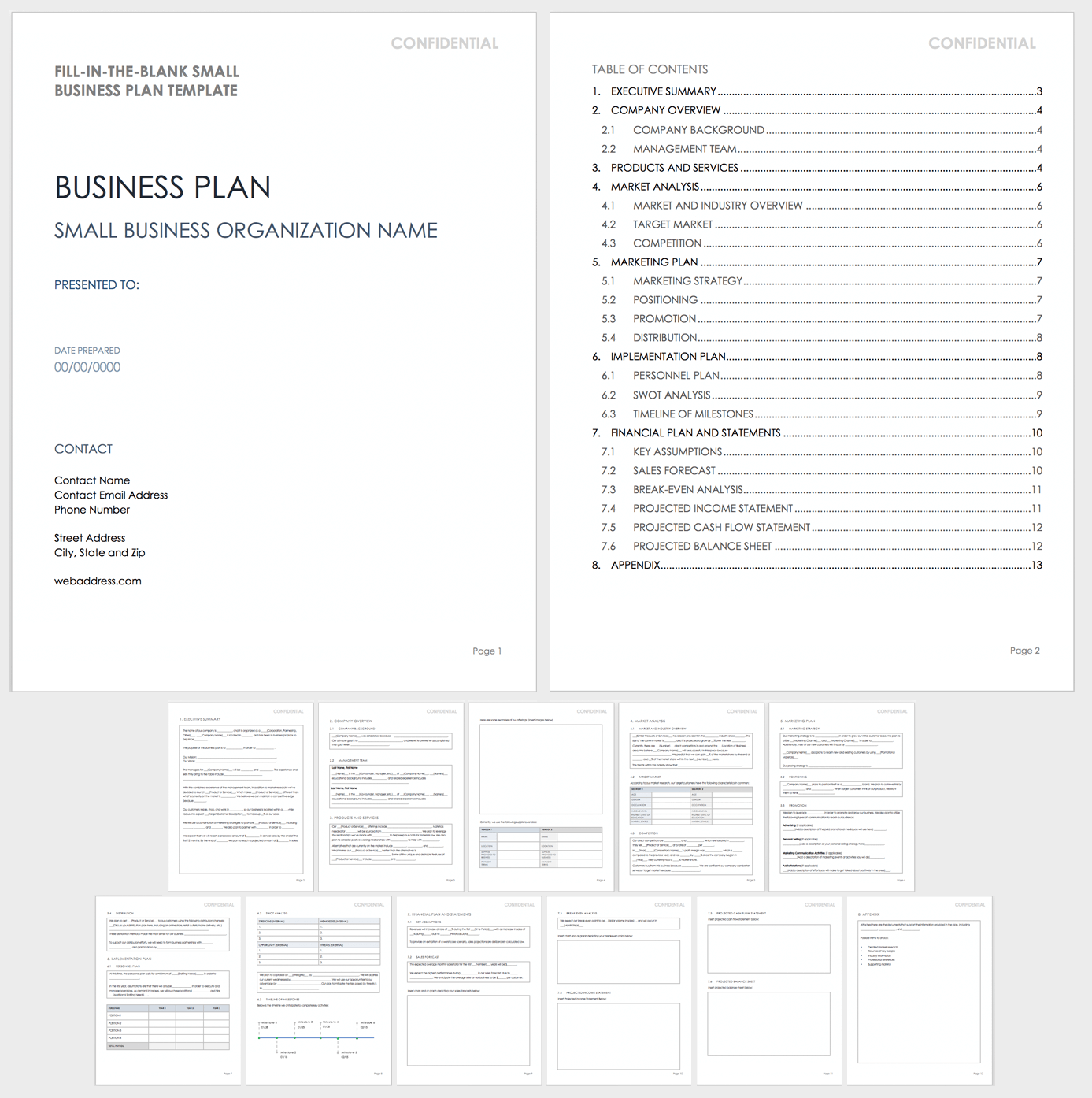
Download Fill-in-the-Blank Small Business Plan Template Microsoft Word | Adobe PDF
This small business plan template simplifies the process to help you create a comprehensive, organized business plan. Simply enter original content for the executive summary, company overview, and other sections to customize the plan. This fill-in-the-blank small business plan template helps you to maintain organization and removes the guesswork in order to ensure success.
One Page Small Business Plan Template
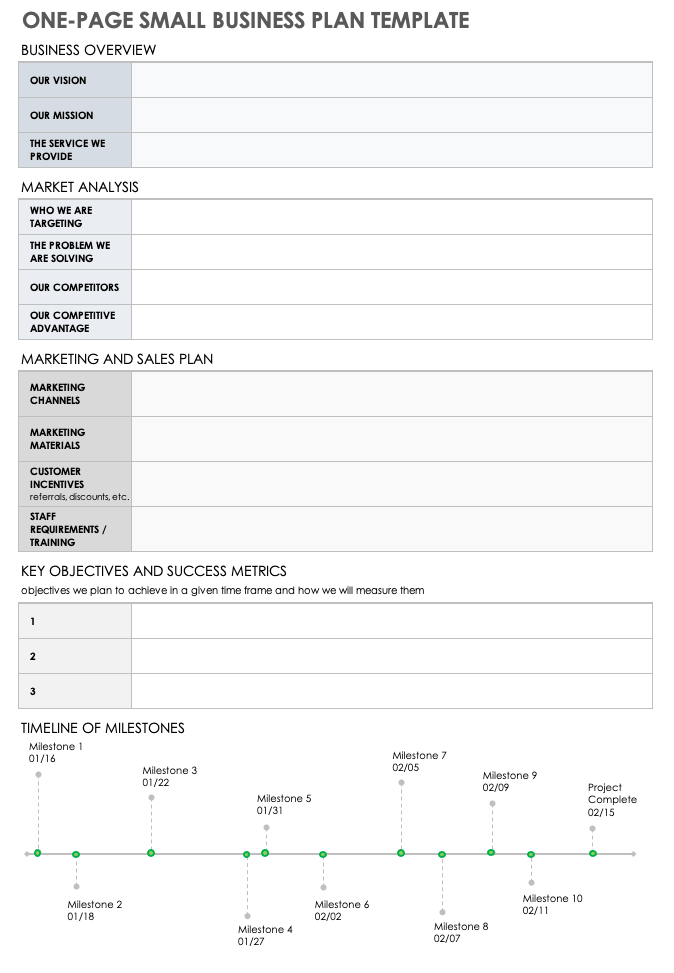
Download One Page Small Business Plan Template Microsoft Excel | Microsoft Word | Adobe PDF
This one page small business plan template is ideal for quick, simple presentations. Use this template to summarize your business overview, market analysis, marketing, and sales plan, key objectives and success metrics, and milestones timeline. Complete the fillable sections to educate investors and inform stakeholders.
One Page Small Business Plan Example
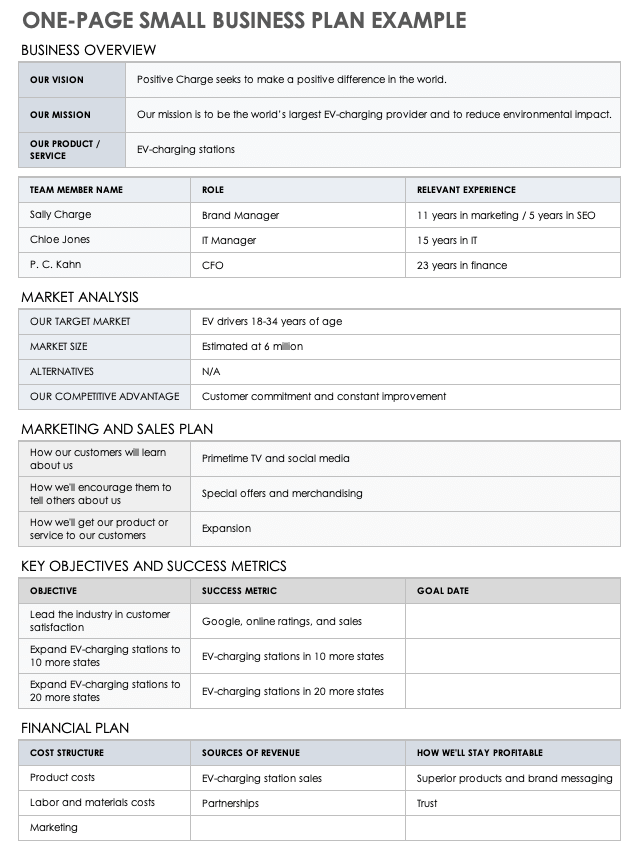
Download One Page Business Plan Example Microsoft Excel | Microsoft Word | Adobe PDF
This one page small business plan example prompts you to list your vision, mission, product or service, team member names, roles, and relevant experience to promote your small business. Use the market analysis, marketing, sales plan sections to detail how you aim to sell your product or service. This small business plan features fillable tables for key objectives and success metrics. Plus, you’ll find space for your financial cost structure and revenue sources to show how your business will remain profitable.
What Is a Small Business Plan Template?
A small business plan template is a roadmap for defining your business objectives and detailing the operational, financial, and marketing resources required for success. Use a small business plan template to strategize growth, forecast financial needs, and promote investment.
A small business plan template organizes and outlines the content needed to achieve goals for growth and profit, including marketing and sales tactics. As opposed to starting from scratch, using a template makes it easy to organize the information and customize the plan to meet your needs.
A small business plan template includes standard business plan sections, as well as the following sections:
- Executive Summary: Summarize the key points in your small business plan in two pages or less to hold your reader's attention and promote buy-in. Write this section last to capitalize on your understanding of the small business plan.
- Company Overview: Describe the nature of your small business, the industry landscape and trends, demographics, and economic and governmental influences. List your location, product or service, and goals to show what makes your small business unique.
- Problem and Solution: Identify and explain the problem your product or service will solve and its costs. Propose and describe your solution and its benefits. Conclude this section with a summary of the problem and solution.
- Target Market: Identify your small business's target market by researching your product and service to determine the most likely demographic. Explain your target market's motivations for buying your product or service.
- Competition: Note the other competitor product or service offerings, pricing, and company revenues to understand how to outperform your competitors. Detail your small business's competitive advantages, based on research.
- Product or Service Offerings: Describe your product or service, how it benefits your target market, and what makes it unique. Highlight how your product or service will outsell competitors.
- Marketing: Detail your marketing plan with objectives and strategy, including goals, costs, and an action plan. A successful marketing plan reduces costs and boosts your product or service sales.
- Timeline and Metrics: Break down your small business plan into smaller activities. Describe these activities (and the performance metrics you intend to use to track them) and list a completion date for each.
- Financial Forecasts: Explain how your organization uses past performance and market research to inform your business's economic forecasts. Estimate growth and profits based on your informed assumptions.
- Financing: List your funding sources and how you intend to use the funds to keep your company on track as it grows. Smart financing at the planning stage prepares your organization for unexpected challenges and helps to mitigate risk.
A small business plan template enables you to complete your business plan quickly and comprehensively, so you can achieve your goals and turn your product or service idea into a profitable reality.
Optimize Your Business Plan with Real-Time Work Management in Smartsheet
Empower your people to go above and beyond with a flexible platform designed to match the needs of your team — and adapt as those needs change.
The Smartsheet platform makes it easy to plan, capture, manage, and report on work from anywhere, helping your team be more effective and get more done. Report on key metrics and get real-time visibility into work as it happens with roll-up reports, dashboards, and automated workflows built to keep your team connected and informed.
When teams have clarity into the work getting done, there’s no telling how much more they can accomplish in the same amount of time. Try Smartsheet for free, today.
Discover why over 90% of Fortune 100 companies trust Smartsheet to get work done.
How to Write a Business Plan: Step-by-Step Guide + Examples

Noah Parsons
24 min. read
Updated July 29, 2024

Writing a business plan doesn’t have to be complicated.
In this step-by-step guide, you’ll learn how to write a business plan that’s detailed enough to impress bankers and potential investors, while giving you the tools to start, run, and grow a successful business.
- The basics of business planning
If you’re reading this guide, then you already know why you need a business plan .
You understand that planning helps you:
- Raise money
- Grow strategically
- Keep your business on the right track
As you start to write your plan, it’s useful to zoom out and remember what a business plan is .
At its core, a business plan is an overview of the products and services you sell, and the customers that you sell to. It explains your business strategy: how you’re going to build and grow your business, what your marketing strategy is, and who your competitors are.
Most business plans also include financial forecasts for the future. These set sales goals, budget for expenses, and predict profits and cash flow.
A good business plan is much more than just a document that you write once and forget about. It’s also a guide that helps you outline and achieve your goals.
After completing your plan, you can use it as a management tool to track your progress toward your goals. Updating and adjusting your forecasts and budgets as you go is one of the most important steps you can take to run a healthier, smarter business.
We’ll dive into how to use your plan later in this article.
There are many different types of plans , but we’ll go over the most common type here, which includes everything you need for an investor-ready plan. However, if you’re just starting out and are looking for something simpler—I recommend starting with a one-page business plan . It’s faster and easier to create.
It’s also the perfect place to start if you’re just figuring out your idea, or need a simple strategic plan to use inside your business.
Dig deeper : How to write a one-page business plan
Brought to you by
Create a professional business plan
Using ai and step-by-step instructions.
Secure funding
Validate ideas
Build a strategy
- What to include in your business plan
Executive summary
The executive summary is an overview of your business and your plans. It comes first in your plan and is ideally just one to two pages. Most people write it last because it’s a summary of the complete business plan.
Ideally, the executive summary can act as a stand-alone document that covers the highlights of your detailed plan.
In fact, it’s common for investors to ask only for the executive summary when evaluating your business. If they like what they see in the executive summary, they’ll often follow up with a request for a complete plan, a pitch presentation , or more in-depth financial forecasts .
Your executive summary should include:
- A summary of the problem you are solving
- A description of your product or service
- An overview of your target market
- A brief description of your team
- A summary of your financials
- Your funding requirements (if you are raising money)
Dig Deeper: How to write an effective executive summary
Products and services description
This is where you describe exactly what you’re selling, and how it solves a problem for your target market. The best way to organize this part of your plan is to start by describing the problem that exists for your customers. After that, you can describe how you plan to solve that problem with your product or service.
This is usually called a problem and solution statement .
To truly showcase the value of your products and services, you need to craft a compelling narrative around your offerings. How will your product or service transform your customers’ lives or jobs? A strong narrative will draw in your readers.
This is also the part of the business plan to discuss any competitive advantages you may have, like specific intellectual property or patents that protect your product. If you have any initial sales, contracts, or other evidence that your product or service is likely to sell, include that information as well. It will show that your idea has traction , which can help convince readers that your plan has a high chance of success.
Market analysis
Your target market is a description of the type of people that you plan to sell to. You might even have multiple target markets, depending on your business.
A market analysis is the part of your plan where you bring together all of the information you know about your target market. Basically, it’s a thorough description of who your customers are and why they need what you’re selling. You’ll also include information about the growth of your market and your industry .
Try to be as specific as possible when you describe your market.
Include information such as age, income level, and location—these are what’s called “demographics.” If you can, also describe your market’s interests and habits as they relate to your business—these are “psychographics.”
Related: Target market examples
Essentially, you want to include any knowledge you have about your customers that is relevant to how your product or service is right for them. With a solid target market, it will be easier to create a sales and marketing plan that will reach your customers. That’s because you know who they are, what they like to do, and the best ways to reach them.
Next, provide any additional information you have about your market.
What is the size of your market ? Is the market growing or shrinking? Ideally, you’ll want to demonstrate that your market is growing over time, and also explain how your business is positioned to take advantage of any expected changes in your industry.
Dig Deeper: Learn how to write a market analysis
Competitive analysis
Part of defining your business opportunity is determining what your competitive advantage is. To do this effectively, you need to know as much about your competitors as your target customers.
Every business has some form of competition. If you don’t think you have competitors, then explore what alternatives there are in the market for your product or service.
For example: In the early years of cars, their main competition was horses. For social media, the early competition was reading books, watching TV, and talking on the phone.
A good competitive analysis fully lays out the competitive landscape and then explains how your business is different. Maybe your products are better made, or cheaper, or your customer service is superior. Maybe your competitive advantage is your location – a wide variety of factors can ultimately give you an advantage.
Dig Deeper: How to write a competitive analysis for your business plan
Marketing and sales plan
The marketing and sales plan covers how you will position your product or service in the market, the marketing channels and messaging you will use, and your sales tactics.
The best place to start with a marketing plan is with a positioning statement .
This explains how your business fits into the overall market, and how you will explain the advantages of your product or service to customers. You’ll use the information from your competitive analysis to help you with your positioning.
For example: You might position your company as the premium, most expensive but the highest quality option in the market. Or your positioning might focus on being locally owned and that shoppers support the local economy by buying your products.
Once you understand your positioning, you’ll bring this together with the information about your target market to create your marketing strategy .
This is how you plan to communicate your message to potential customers. Depending on who your customers are and how they purchase products like yours, you might use many different strategies, from social media advertising to creating a podcast. Your marketing plan is all about how your customers discover who you are and why they should consider your products and services.
While your marketing plan is about reaching your customers—your sales plan will describe the actual sales process once a customer has decided that they’re interested in what you have to offer.
If your business requires salespeople and a long sales process, describe that in this section. If your customers can “self-serve” and just make purchases quickly on your website, describe that process.
A good sales plan picks up where your marketing plan leaves off. The marketing plan brings customers in the door and the sales plan is how you close the deal.
Together, these specific plans paint a picture of how you will connect with your target audience, and how you will turn them into paying customers.
Dig deeper: What to include in your sales and marketing plan
Business operations
The operations section describes the necessary requirements for your business to run smoothly. It’s where you talk about how your business works and what day-to-day operations look like.
Depending on how your business is structured, your operations plan may include elements of the business like:
- Supply chain management
- Manufacturing processes
- Equipment and technology
- Distribution
Some businesses distribute their products and reach their customers through large retailers like Amazon.com, Walmart, Target, and grocery store chains.
These businesses should review how this part of their business works. The plan should discuss the logistics and costs of getting products onto store shelves and any potential hurdles the business may have to overcome.
If your business is much simpler than this, that’s OK. This section of your business plan can be either extremely short or more detailed, depending on the type of business you are building.
For businesses selling services, such as physical therapy or online software, you can use this section to describe the technology you’ll leverage, what goes into your service, and who you will partner with to deliver your services.
Dig Deeper: Learn how to write the operations chapter of your plan
Key milestones and metrics
Although it’s not required to complete your business plan, mapping out key business milestones and the metrics can be incredibly useful for measuring your success.
Good milestones clearly lay out the parameters of the task and set expectations for their execution. You’ll want to include:
- A description of each task
- The proposed due date
- Who is responsible for each task
If you have a budget, you can include projected costs to hit each milestone. You don’t need extensive project planning in this section—just list key milestones you want to hit and when you plan to hit them. This is your overall business roadmap.
Possible milestones might be:
- Website launch date
- Store or office opening date
- First significant sales
- Break even date
- Business licenses and approvals
You should also discuss the key numbers you will track to determine your success. Some common metrics worth tracking include:
- Conversion rates
- Customer acquisition costs
- Profit per customer
- Repeat purchases
It’s perfectly fine to start with just a few metrics and grow the number you are tracking over time. You also may find that some metrics simply aren’t relevant to your business and can narrow down what you’re tracking.
Dig Deeper: How to use milestones in your business plan
Organization and management team
Investors don’t just look for great ideas—they want to find great teams. Use this chapter to describe your current team and who you need to hire . You should also provide a quick overview of your location and history if you’re already up and running.
Briefly highlight the relevant experiences of each key team member in the company. It’s important to make the case for why yours is the right team to turn an idea into a reality.
Do they have the right industry experience and background? Have members of the team had entrepreneurial successes before?
If you still need to hire key team members, that’s OK. Just note those gaps in this section.
Your company overview should also include a summary of your company’s current business structure . The most common business structures include:
- Sole proprietor
- Partnership
Be sure to provide an overview of how the business is owned as well. Does each business partner own an equal portion of the business? How is ownership divided?
Potential lenders and investors will want to know the structure of the business before they will consider a loan or investment.
Dig Deeper: How to write about your company structure and team
Financial plan
Last, but certainly not least, is your financial plan chapter.
Entrepreneurs often find this section the most daunting. But, business financials for most startups are less complicated than you think, and a business degree is certainly not required to build a solid financial forecast.
A typical financial forecast in a business plan includes the following:
- Sales forecast : An estimate of the sales expected over a given period. You’ll break down your forecast into the key revenue streams that you expect to have.
- Expense budget : Your planned spending such as personnel costs , marketing expenses, and taxes.
- Profit & Loss : Brings together your sales and expenses and helps you calculate planned profits.
- Cash Flow : Shows how cash moves into and out of your business. It can predict how much cash you’ll have on hand at any given point in the future.
- Balance Sheet : A list of the assets, liabilities, and equity in your company. In short, it provides an overview of the financial health of your business.
A strong business plan will include a description of assumptions about the future, and potential risks that could impact the financial plan. Including those will be especially important if you’re writing a business plan to pursue a loan or other investment.
Dig Deeper: How to create financial forecasts and budgets
This is the place for additional data, charts, or other information that supports your plan.
Including an appendix can significantly enhance the credibility of your plan by showing readers that you’ve thoroughly considered the details of your business idea, and are backing your ideas up with solid data.
Just remember that the information in the appendix is meant to be supplementary. Your business plan should stand on its own, even if the reader skips this section.
Dig Deeper : What to include in your business plan appendix
Optional: Business plan cover page
Adding a business plan cover page can make your plan, and by extension your business, seem more professional in the eyes of potential investors, lenders, and partners. It serves as the introduction to your document and provides necessary contact information for stakeholders to reference.
Your cover page should be simple and include:
- Company logo
- Business name
- Value proposition (optional)
- Business plan title
- Completion and/or update date
- Address and contact information
- Confidentiality statement
Just remember, the cover page is optional. If you decide to include it, keep it very simple and only spend a short amount of time putting it together.
Dig Deeper: How to create a business plan cover page
How to use AI to help write your business plan
Generative AI tools such as ChatGPT can speed up the business plan writing process and help you think through concepts like market segmentation and competition. These tools are especially useful for taking ideas that you provide and converting them into polished text for your business plan.
The best way to use AI for your business plan is to leverage it as a collaborator , not a replacement for human creative thinking and ingenuity.
AI can come up with lots of ideas and act as a brainstorming partner. It’s up to you to filter through those ideas and figure out which ones are realistic enough to resonate with your customers.
There are pros and cons of using AI to help with your business plan . So, spend some time understanding how it can be most helpful before just outsourcing the job to AI.
Learn more: 10 AI prompts you need to write a business plan
- Writing tips and strategies
To help streamline the business plan writing process, here are a few tips and key questions to answer to make sure you get the most out of your plan and avoid common mistakes .
Determine why you are writing a business plan
Knowing why you are writing a business plan will determine your approach to your planning project.
For example: If you are writing a business plan for yourself, or just to use inside your own business , you can probably skip the section about your team and organizational structure.
If you’re raising money, you’ll want to spend more time explaining why you’re looking to raise the funds and exactly how you will use them.
Regardless of how you intend to use your business plan , think about why you are writing and what you’re trying to get out of the process before you begin.
Keep things concise
Probably the most important tip is to keep your business plan short and simple. There are no prizes for long business plans . The longer your plan is, the less likely people are to read it.
So focus on trimming things down to the essentials your readers need to know. Skip the extended, wordy descriptions and instead focus on creating a plan that is easy to read —using bullets and short sentences whenever possible.
Have someone review your business plan
Writing a business plan in a vacuum is never a good idea. Sometimes it’s helpful to zoom out and check if your plan makes sense to someone else. You also want to make sure that it’s easy to read and understand.
Don’t wait until your plan is “done” to get a second look. Start sharing your plan early, and find out from readers what questions your plan leaves unanswered. This early review cycle will help you spot shortcomings in your plan and address them quickly, rather than finding out about them right before you present your plan to a lender or investor.
If you need a more detailed review, you may want to explore hiring a professional plan writer to thoroughly examine it.
Use a free business plan template and business plan examples to get started
Knowing what information to include in a business plan is sometimes not quite enough. If you’re struggling to get started or need additional guidance, it may be worth using a business plan template.
There are plenty of great options available (we’ve rounded up our 8 favorites to streamline your search).
But, if you’re looking for a free downloadable business plan template , you can get one right now; download the template used by more than 1 million businesses.
Or, if you just want to see what a completed business plan looks like, check out our library of over 550 free business plan examples .
We even have a growing list of industry business planning guides with tips for what to focus on depending on your business type.
Common pitfalls and how to avoid them
It’s easy to make mistakes when you’re writing your business plan. Some entrepreneurs get sucked into the writing and research process, and don’t focus enough on actually getting their business started.
Here are a few common mistakes and how to avoid them:
Not talking to your customers : This is one of the most common mistakes. It’s easy to assume that your product or service is something that people want. Before you invest too much in your business and too much in the planning process, make sure you talk to your prospective customers and have a good understanding of their needs.
- Overly optimistic sales and profit forecasts: By nature, entrepreneurs are optimistic about the future. But it’s good to temper that optimism a little when you’re planning, and make sure your forecasts are grounded in reality.
- Spending too much time planning: Yes, planning is crucial. But you also need to get out and talk to customers, build prototypes of your product and figure out if there’s a market for your idea. Make sure to balance planning with building.
- Not revising the plan: Planning is useful, but nothing ever goes exactly as planned. As you learn more about what’s working and what’s not—revise your plan, your budgets, and your revenue forecast. Doing so will provide a more realistic picture of where your business is going, and what your financial needs will be moving forward.
- Not using the plan to manage your business: A good business plan is a management tool. Don’t just write it and put it on the shelf to collect dust – use it to track your progress and help you reach your goals.
- Presenting your business plan
The planning process forces you to think through every aspect of your business and answer questions that you may not have thought of. That’s the real benefit of writing a business plan – the knowledge you gain about your business that you may not have been able to discover otherwise.
With all of this knowledge, you’re well prepared to convert your business plan into a pitch presentation to present your ideas.
A pitch presentation is a summary of your plan, just hitting the highlights and key points. It’s the best way to present your business plan to investors and team members.
Dig Deeper: Learn what key slides should be included in your pitch deck
Use your business plan to manage your business
One of the biggest benefits of planning is that it gives you a tool to manage your business better. With a revenue forecast, expense budget, and projected cash flow, you know your targets and where you are headed.
And yet, nothing ever goes exactly as planned – it’s the nature of business.
That’s where using your plan as a management tool comes in. The key to leveraging it for your business is to review it periodically and compare your forecasts and projections to your actual results.
Start by setting up a regular time to review the plan – a monthly review is a good starting point. During this review, answer questions like:
- Did you meet your sales goals?
- Is spending following your budget?
- Has anything gone differently than what you expected?
Now that you see whether you’re meeting your goals or are off track, you can make adjustments and set new targets.
Maybe you’re exceeding your sales goals and should set new, more aggressive goals. In that case, maybe you should also explore more spending or hiring more employees.
Or maybe expenses are rising faster than you projected. If that’s the case, you would need to look at where you can cut costs.
A plan, and a method for comparing your plan to your actual results , is the tool you need to steer your business toward success.
Learn More: How to run a regular plan review
How to write a business plan FAQ
What is a business plan?
A document that describes your business , the products and services you sell, and the customers that you sell to. It explains your business strategy, how you’re going to build and grow your business, what your marketing strategy is, and who your competitors are.
What are the benefits of a business plan?
A business plan helps you understand where you want to go with your business and what it will take to get there. It reduces your overall risk, helps you uncover your business’s potential, attracts investors, and identifies areas for growth.
Having a business plan ultimately makes you more confident as a business owner and more likely to succeed for a longer period of time.
What are the 7 steps of a business plan?
The seven steps to writing a business plan include:
- Write a brief executive summary
- Describe your products and services.
- Conduct market research and compile data into a cohesive market analysis.
- Describe your marketing and sales strategy.
- Outline your organizational structure and management team.
- Develop financial projections for sales, revenue, and cash flow.
- Add any additional documents to your appendix.
What are the 5 most common business plan mistakes?
There are plenty of mistakes that can be made when writing a business plan. However, these are the 5 most common that you should do your best to avoid:
- 1. Not taking the planning process seriously.
- Having unrealistic financial projections or incomplete financial information.
- Inconsistent information or simple mistakes.
- Failing to establish a sound business model.
- Not having a defined purpose for your business plan.
What questions should be answered in a business plan?
Writing a business plan is all about asking yourself questions about your business and being able to answer them through the planning process. You’ll likely be asking dozens and dozens of questions for each section of your plan.
However, these are the key questions you should ask and answer with your business plan:
- How will your business make money?
- Is there a need for your product or service?
- Who are your customers?
- How are you different from the competition?
- How will you reach your customers?
- How will you measure success?
How long should a business plan be?
The length of your business plan fully depends on what you intend to do with it. From the SBA and traditional lender point of view, a business plan needs to be whatever length necessary to fully explain your business. This means that you prove the viability of your business, show that you understand the market, and have a detailed strategy in place.
If you intend to use your business plan for internal management purposes, you don’t necessarily need a full 25-50 page business plan. Instead, you can start with a one-page plan to get all of the necessary information in place.
What are the different types of business plans?
While all business plans cover similar categories, the style and function fully depend on how you intend to use your plan. Here are a few common business plan types worth considering.
Traditional business plan: The tried-and-true traditional business plan is a formal document meant to be used when applying for funding or pitching to investors. This type of business plan follows the outline above and can be anywhere from 10-50 pages depending on the amount of detail included, the complexity of your business, and what you include in your appendix.
Business model canvas: The business model canvas is a one-page template designed to demystify the business planning process. It removes the need for a traditional, copy-heavy business plan, in favor of a single-page outline that can help you and outside parties better explore your business idea.
One-page business plan: This format is a simplified version of the traditional plan that focuses on the core aspects of your business. You’ll typically stick with bullet points and single sentences. It’s most useful for those exploring ideas, needing to validate their business model, or who need an internal plan to help them run and manage their business.
Lean Plan: The Lean Plan is less of a specific document type and more of a methodology. It takes the simplicity and styling of the one-page business plan and turns it into a process for you to continuously plan, test, review, refine, and take action based on performance. It’s faster, keeps your plan concise, and ensures that your plan is always up-to-date.
What’s the difference between a business plan and a strategic plan?
A business plan covers the “who” and “what” of your business. It explains what your business is doing right now and how it functions. The strategic plan explores long-term goals and explains “how” the business will get there. It encourages you to look more intently toward the future and how you will achieve your vision.
However, when approached correctly, your business plan can actually function as a strategic plan as well. If kept lean, you can define your business, outline strategic steps, and track ongoing operations all with a single plan.
Noah is the COO at Palo Alto Software, makers of the online business plan app LivePlan. He started his career at Yahoo! and then helped start the user review site Epinions.com. From there he started a software distribution business in the UK before coming to Palo Alto Software to run the marketing and product teams.

Table of Contents
- Use AI to help write your plan
- Common planning mistakes
- Manage with your business plan
Related Articles

7 Min. Read
How to Write a Bakery Business Plan + Sample

5 Min. Read
How To Write a Business Plan for a Life Coaching Business + Free Example

3 Min. Read
What to Include in Your Business Plan Appendix

1 Min. Read
How to Calculate Return on Investment (ROI)
The LivePlan Newsletter
Become a smarter, more strategic entrepreneur.
Your first monthly newsetter will be delivered soon..
Unsubscribe anytime. Privacy policy .

The quickest way to turn a business idea into a business plan
Fill-in-the-blanks and automatic financials make it easy.
No thanks, I prefer writing 40-page documents.

Discover the world’s #1 plan building software

Personal Business Plan

Did you have a dream of one day owning your business ? If so, what was your dream about? When I was young, I always dreamed of owning my own business and seeing it flourish . I told myself that one day, I would be able to own a business that involved a hybrid of a coffee and tea shop with a library and a place where animal lovers could simply hang out. Of course that dream is still in the air as it takes a lot of planning and a lot of resources like financial and material resources to make it happen. Another thing to also take into consideration is to have your own plans. Not just one plan but if possible a lot of back up plans that go along with it. Even if your plan may seem or look fool proof, there is still a possibility that you may need to redo it or to have at least a back up plan along with your original plan. What am I even talking about? A business plan of course. Your personal business plan. The difference between a business plan and a personal business plan is found in the article below. So check it all out right now.
8+ Personal Business Plan Examples
1. personal financial business plan template.
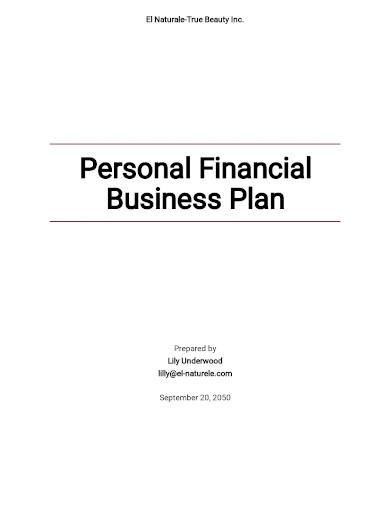
2. Personal Trainer Business Plan Template
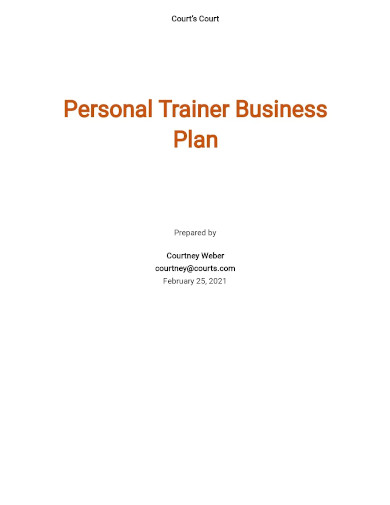
- Google Docs
- Apple Pages
3. Sample Personal Business Plan Template

Size: 153 KB
4. Individual Lawyer’s Business Plan Worksheet

Size: 275 KB
5. Personal Development Plan in PDF

Size: 85 KB
6. Personal Business Plan Format
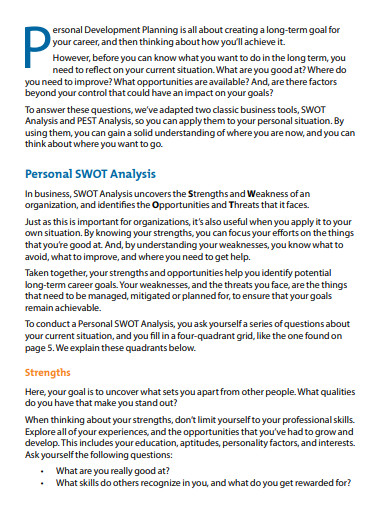
Size: 322 KB
7. Middle School Business Plan

Size: 95 KB
8. Personal Leadership Development Plan

Size: 263 KB
9. Individual Development Plan Template

Size: 643 KB
What Is a Personal Business Plan?
A lot of people would associate a business plan to a business or a company. But they may never associate the term business plan with personal . However, you can make your own business plan, and it does not have to be focused on a business or a company that you own. It can also focus on you, your family life, personal life, and your development. So what is a personal business plan? A personal business plan is a tool . This tool helps you by giving you a tour, a guide or serves as a road map for you to know how and where you can start out by changing what you want to do in life, or to change something in your business to make it better. For this case, a personal business plan is more associated with how you view yourself and your goals to achieve them. The importance of a personal business plan is to simply help you. Help you by giving you directions. A step by step plan that shows you or how you want to see your future in specific years to come. To show if there is any development that you have made or none at all.
How to Write a Personal Business Plan?
Here’s a fun fact for you. Did you know that having a personal business plan can help you ? Apart from having a positive mindset, having a personal development plan or a personal business plan is also quite helpful. Though it may depend on how you perceive it and use it, but it really is a helpful tool. Something to help you get started on writing are these simple yet easy to do tips.
1. Get To Know What You Want to Write
What this means is, brainstorm. What do you want to write, what do you expect to write and what do you really want to see in your personal development? These are just basic questions to help you when you brainstorm on what you want to place in your personal business plan. The topics could range from family, your dreams, your goals, anything that is achievable. Start from there.
2. Set Your Goals and Objectives
Know your goals and know your objectives . Understand the factors when picking your goals. Always choose an attainable goal. In addition to that, always choose an attainable objective or a series of attainable objectives. This is going to be your guide when you choose what goal you want to achieve. So to make that happen, you must make it happen. It must be achievable. Something possible, not impossible.
3. Make Your Goals Very Specific
One thing you may have noticed is why should you make your goals very specific ? The reason for this is because if you do not make your goals specific, you may end up getting frustrated or end up not bothering to achieve the goal you want. For this to be avoided, it is always best to make every single thing in your plan specific, especially your goals.
4. Set Up Deadlines for Each Goal
In addition to the tips above, here is another tip I can give you. Set up deadlines . For each goal you plan on doing, set up a deadline. Not only will this encourage you to do better and to really find ways to achieve them, it also gives you a sense of accomplishment and responsibility. This is where your development should already be showing.
5. Update Your Progress Plan
Last but not the least, update on the progress you have made. Whether it be a huge milestone or a smaller and simple one. Each milestone you have made is considered progress and should be updated to your plan. This is to show you how far you have gone to reach the goal you decided to do and how far you still need to go and push through to achieve it.
What is a personal business plan?
A personal business plan can also be coined as a personal development plan. This kind of plan is used as a personal growth plan for a person. It helps by outlining your goals and objectives and to record every milestone that has been accomplished at a certain amount of time.
What can a personal business plan be used for?
A personal business plan can be used in a way to help you reach your full potential. It helps by showing you the steps and the things that you can do to reach it.
Is it difficult to make your own personal business plan?
Not at all. Planning on making your own business plan is quite easy. It only takes a few simple steps. To know more about these steps, you can simply check the How to write a personal business plan found in this article.
When you want your dreams to come true, you work hard for it. When you want your goals in life to be achieved, you work hard for it. But there are times that we often mistake what we think we can do to what we can actually do. Always remember that you can achieve those dreams if they are realistic and doable. As well as adding a personal business plan to the mix.
Text prompt
- Instructive
- Professional
Create a study plan for final exams in high school
Develop a project timeline for a middle school science fair.
Restaurant Management Blog
How to Start a Coffee Shop Business Plan

Starting a coffee shop is a popular entrepreneurial venture due to the growing demand for specialty coffee and a comfortable place for social interaction. A well-structured business plan is crucial for the success of any coffee shop. It serves as a roadmap, guiding you through the process of starting and growing your business. Below is a comprehensive guide to help you develop a business plan for a coffee shop.
1. Executive Summary
The executive summary is the first section of your business plan but should be written last. It provides a concise overview of your business plan and should capture the essence of your coffee shop.
- Mission Statement: Define the purpose of your coffee shop. For example, “To provide a cozy and inviting space where customers can enjoy high-quality coffee, local pastries, and a friendly atmosphere.”
- Vision Statement: Describe the long-term vision for your coffee shop, such as expanding to multiple locations or becoming a well-known community hub.
- Business Objectives: Outline your short-term and long-term goals. These could include achieving profitability within a year, building a loyal customer base, or gaining recognition as a top coffee shop in your area.
2. Company Description
This section provides more detailed information about your coffee shop.
- Business Structure: Indicate the legal structure of your business (e.g., sole proprietorship, partnership, LLC, corporation).
- Ownership: Describe who owns the business and their respective roles.
- Location: Mention the physical location of your coffee shop or the planned location if you haven’t secured it yet. Discuss why this location is ideal (e.g., high foot traffic, proximity to offices, etc.).
- Products and Services: Provide an overview of what your coffee shop will offer. This includes coffee, tea, pastries, light meals, and any other products or services like catering or coffee beans for sale.
- Unique Selling Proposition (USP): Explain what sets your coffee shop apart from competitors. It could be your unique coffee blends, eco-friendly practices, or a specific theme.
3. Market Analysis
Conducting thorough market research is essential to understanding your target market and competition.
- Industry Overview: Discuss the coffee shop industry, including trends, market size, and growth potential.
- Target Market: Identify your ideal customers. Consider demographics (age, gender, income), psychographics (lifestyle, interests), and behaviors (frequency of coffee consumption, preference for specialty coffee).
- Market Need: Explain the demand for your coffee shop in the chosen location. Highlight any gaps in the market that your coffee shop will fill.
- Competitive Analysis: Analyze your competitors, including direct (other coffee shops) and indirect (cafes, bakeries) competitors. Discuss their strengths and weaknesses and how you plan to differentiate your business.
4. Marketing and Sales Strategy
Your marketing and sales strategy outlines how you will attract and retain customers.
- Branding: Define your coffee shop’s brand, including logo, color scheme, and brand messaging. Your brand should reflect your coffee shop’s identity and appeal to your target market.
- Pricing Strategy: Determine your pricing strategy based on costs, competition, and customer willingness to pay. Consider whether you will position yourself as a premium brand or offer more budget-friendly options.
- Promotion and Advertising: Outline your promotional strategies, including social media marketing, email campaigns, loyalty programs, and community events. Discuss any partnerships with local businesses or influencers.
- Sales Strategy: Describe how you will sell your products, including your point-of-sale system, payment methods, and upselling techniques.
5. Operations Plan
The operations plan details the day-to-day operations of your coffee shop.
- Location and Facilities: Describe the layout and design of your coffee shop, including seating capacity, kitchen equipment, and decor. Consider the customer flow and how it will enhance the customer experience.
- Suppliers: List your suppliers for coffee beans, tea, pastries, and other ingredients. Establish relationships with reliable suppliers to ensure consistent quality and supply.
- Technology: Discuss any technology you will use, such as a POS system , inventory management software , or an online ordering platform.
- Staffing: Outline your staffing needs, including baristas, kitchen staff, and management. Discuss your hiring process, training programs, and employee benefits.
- Operating Hours: Determine your coffee shop’s operating hours based on customer demand and competitor analysis.
6. Management and Organization
This section provides information about the management team and organizational structure.
- Management Team: Introduce the key members of your management team, including their roles, experience, and qualifications. If you’re the sole owner, describe your background and expertise in the coffee industry.
- Organizational Structure: Create an organizational chart showing the hierarchy of roles and responsibilities within your coffee shop. Include positions such as manager, barista, kitchen staff, and support roles.
- Advisors: Mention any advisors or consultants you plan to work with, such as a business coach, accountant, or legal advisor.
7. Financial Plan
The financial plan is one of the most critical sections of your business plan, as it outlines your coffee shop’s financial projections and funding needs.
- Startup Costs: List all the initial costs associated with opening your coffee shop. This includes rent, equipment, inventory, licenses, and marketing expenses. Be as detailed as possible to avoid any surprises.
- Funding Requirements: If you’re seeking funding, specify how much capital you need and how you plan to use it. Include information on any loans, grants, or investor contributions.
- Revenue Projections: Estimate your coffee shop’s expected revenue for the first three to five years. Break down revenue by product category (e.g., coffee, pastries) and by month or quarter.
- Cost Projections: Detail your projected expenses, including fixed costs (rent, salaries) and variable costs (ingredients, utilities). Calculate your break-even point to understand when your business will become profitable.
- Profit and Loss Statement: Create a projected profit and loss statement (also known as an income statement) that shows your expected income, expenses, and net profit over time.
- Cash Flow Statement: Outline your cash flow projections to ensure you have enough cash on hand to cover expenses. This is especially important in the early stages when cash flow can be tight.
- Balance Sheet: Provide a projected balance sheet that lists your assets, liabilities, and equity. This will give potential investors or lenders a clear picture of your financial position.
8. Appendix
The appendix includes any additional information that supports your business plan.
- Resumes: Include resumes of key management team members.
- Market Research Data: Attach any relevant market research data, surveys, or studies that support your market analysis.
- Supplier Contracts: Provide copies of contracts or agreements with suppliers.
- Legal Documents: Include any necessary legal documents, such as business licenses, permits, or lease agreements.
- Product Photos: If you have photos of your coffee shop’s interior, menu items, or branding materials, include them here to give readers a visual sense of your business.
9. Tips for a Successful Coffee Shop Business Plan
Creating a successful business plan for your coffee shop requires attention to detail and a deep understanding of the industry. Here are some additional tips to help you along the way:
- Research Thoroughly: Conduct in-depth research on the coffee shop industry, your target market, and competitors. The more information you have, the better equipped you’ll be to make informed decisions.
- Be Realistic: While it’s important to be optimistic about your coffee shop’s potential, it’s also crucial to be realistic. Avoid overestimating revenue or underestimating costs. Conservative estimates will help you prepare for any challenges that may arise.
- Seek Feedback: Don’t hesitate to seek feedback on your business plan from trusted advisors, mentors, or industry experts. They can provide valuable insights and help you identify any weaknesses in your plan.
- Keep It Updated: Your business plan is a living document that should evolve as your coffee shop grows. Regularly review and update it to reflect changes in the market, your business goals, or financial situation.
- Focus on the Customer Experience: In the coffee shop industry, customer experience is paramount. Your business plan should emphasize how you will create a welcoming and enjoyable environment for your customers, from the quality of your coffee to the ambiance of your shop.
Starting a coffee shop is an exciting and rewarding venture, but it requires careful planning and execution. A well-crafted business plan is essential to guide you through the process and ensure your coffee shop’s success. By following the steps outlined in this guide, you’ll be well on your way to creating a thriving coffee shop that delights customers and stands out in a competitive market.
Related Posts

How to Open a Cafe With a Low Budget

How to Start Your Own Coffee Shop in South Africa

Coffee Shop Owner Salary and Job Description

COMMENTS
Lean Business Plan Template PDF. This scannable business plan template allows you to easily identify the most important elements of your plan. Use this template to outline key details pertaining to your business and industry, product or service offerings, target customer segments (and channels to reach them), and to identify sources of revenue.
Download or view 14 business plans examples/samples, vetted by our MBA business plan writers. Download in PDF format or read like a book. These real business plan samples would help in writing your own business plan. Download Pack of 14 Business Plan Examples FREE.
What You'll Get: A complete business plan Unlike other blank templates, our business plan examples are complete business plans with all of the text and financial forecasts already filled out. Edit the text to make the plan your own and save hundreds of hours. A professional business plan template All 550 of our business plans are in the SBA-approved format that's proven to raise money from ...
%PDF-1.6 %âãÏÓ 970 0 obj >stream hÞìXÛn G ý•y´ fwgv®…a@Ö%1ÚȆ¬&El?¬åµ-@ cµnã¿ïá ×7(i ...
Download Simple Small-Business Plan Template. Word | PDF. This template walks you through each component of a small-business plan, including the company background, the introduction of the management team, market analysis, product or service offerings, a financial plan, and more. This template also comes with a built-in table of contents to ...
Download a free business plan template in Google Doc, Microsoft Word, and PDF formats. Includes expert guidance to help fill out each section. Why you need a business plan template Writing a business plan can seem like a big task, especially if you're starting a business for the first time and don't have a financial background.
Strategic Plan Template. Focus on the future and keep your company moving forward with Jotform's Strategic Plan Template. Simply fill in the attached form with your company overview, delve deeper with a SWOT analysis, and finish off by determining your strategic goals, actions, and financial plans. Our fully-customizable template converts ...
Content marketing software. Free and premium plans. Operations Hub. Operations software. Free and premium plans. Commerce Hub. B2B commerce software. Free and premium plans. A collection of professionally designed Business Plans templates available for PDF. Download, customize, and send in minutes.
The rest, while still useful, go a bit lighter on guidance in favor of tailoring the plan to a specific industry. Explore: PandaDoc's business plan template library. 5. Canva — Pitch with your plan. Canva is a great option for building a visually stunning business plan that can be used as a pitch tool.
Available as a one-page interactive PDF and a full template on both Google Docs and Microsoft Word! Whether you're starting a business or drafting a formalized document with your current business goals, it's important to clearly defi ne the scope of all aspects of the venture — from mission, to target customers, to fi nances, and beyond.
Sample business plan format Following is the standard business plan format you must consider while drafting a comprehensive business plan. Executive Summary: A high-level overview of your business plan.; Company Overview: An in-depth and detailed description of your small business, its fundamental elements, and future goals.; Market Analysis: A detailed description of your industry with the ...
Growthink's business plan template is a comprehensive guide to help entrepreneurs and business owners create a professional and effective plan for their companies. NOTE: The following template is the FREE version of Growthink's Ultimate Business Plan Template. Much of the information from the paid version, including the integrated financial ...
A good business plan guides you through each stage of starting and managing your business. You'll use your business plan as a roadmap for how to structure, run, and grow your new business. It's a way to think through the key elements of your business. Business plans can help you get funding or bring on new business partners.
Start with a cogent and concise one sentence statement of the business idea. A sentence that is so clear and appealing that the reader can immediately visualise or 'see' the business. You can then go on to describe: The market at which you are aiming. The specific benefits offered by your product or service.
The business model canvas is a one-page template designed to demystify the business planning process. It removes the need for a traditional, copy-heavy business plan, in favor of a single-page outline that can help you and outside parties better explore your business idea. The structure ditches a linear format in favor of a cell-based template.
the Business it is agreed that the Recipient undertakes to the Business to treat as confidential the Business Plan and all information in any medium or format (whether marked "confidential" or not) whether in writing or oral which the Recipient receives during the relationship from the Business ( Confidential Information ). 2. The Recipient ...
Sharing your business plan as a PDF also allows for easy collaboration, with no subscription required and the ability to add comments, highlights and notes with our free online PDF editor tool. Top Tips for Your Business Plan. Writing a business plan template is easier with these top tips, so you can get off to a smooth start - whatever your ...
This one page small business plan template is ideal for quick, simple presentations. Use this template to summarize your business overview, market analysis, marketing, and sales plan, key objectives and success metrics, and milestones timeline. Complete the fillable sections to educate investors and inform stakeholders.
A. Vision Statement. The vision/mission statements are clear summaries of where the business is headed. It describes what the business produces, who products are produced for, and unique business characteristics. It will reflect the values of the management team and the type of business culture you are trying to create.
Version Rebecca's Plan-Traditional | File size: 245KB | Download .doc for Rebecca's Plan-Traditional /. Version Andrew's Plan - Traditional | File size: 244KB | Download .doc for Andrew's Plan - Traditional /. Version Andrew's Lean Business Plan | File size: 247KB | Download .doc for Andrew's Lean Business Plan /.
Most business plans also include financial forecasts for the future. These set sales goals, budget for expenses, and predict profits and cash flow. A good business plan is much more than just a document that you write once and forget about. It's also a guide that helps you outline and achieve your goals. After completing your plan, you can ...
For this case, a personal business plan is more associated with how you view yourself and your goals to achieve them. The importance of a personal business plan is to simply help you. Help you by giving you directions. A step by step plan that shows you or how you want to see your future in specific years to come.
Tips for a Successful Coffee Shop Business Plan. Creating a successful business plan for your coffee shop requires attention to detail and a deep understanding of the industry. Here are some additional tips to help you along the way: Research Thoroughly: Conduct in-depth research on the coffee shop industry, your target market, and competitors ...